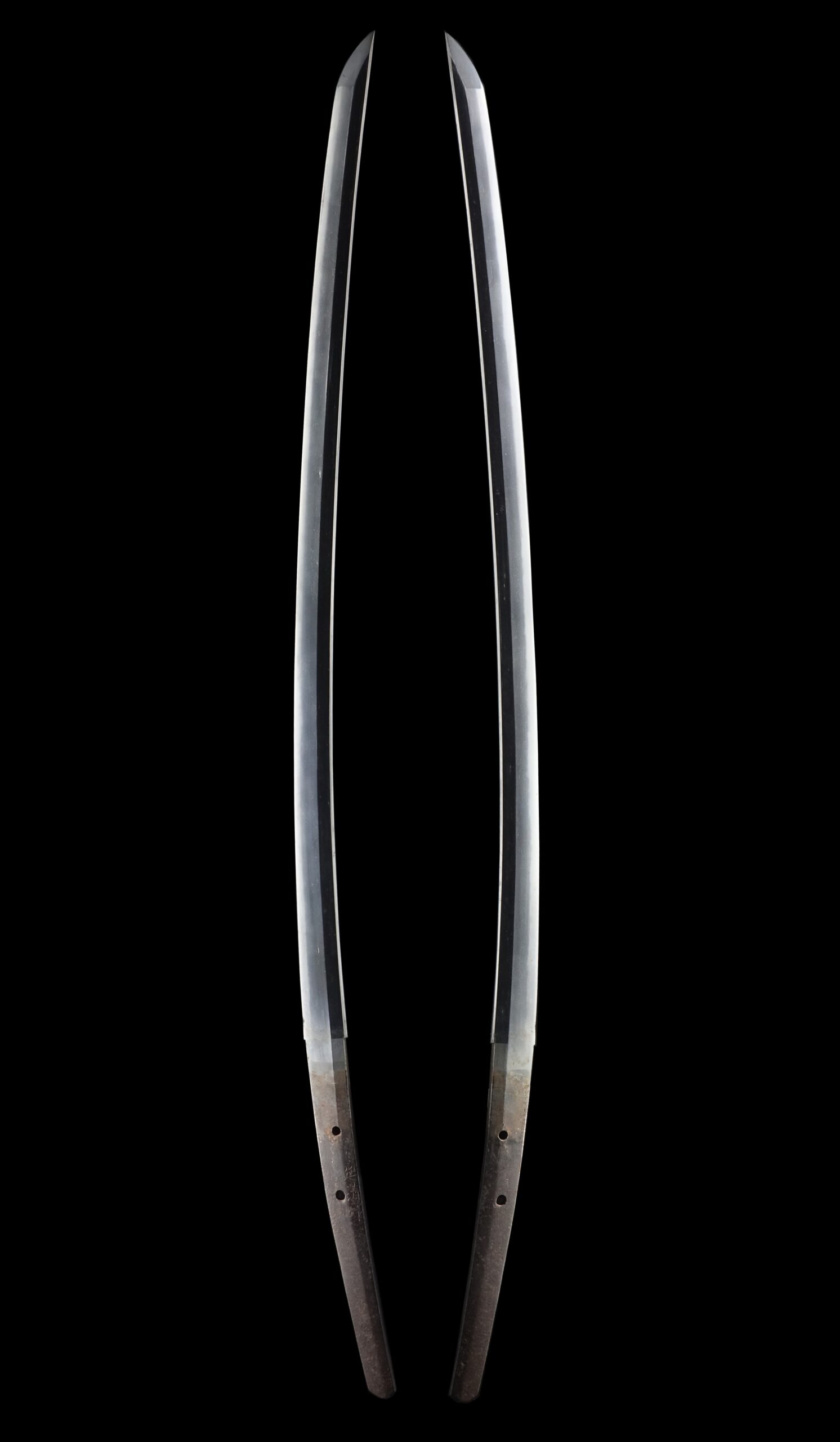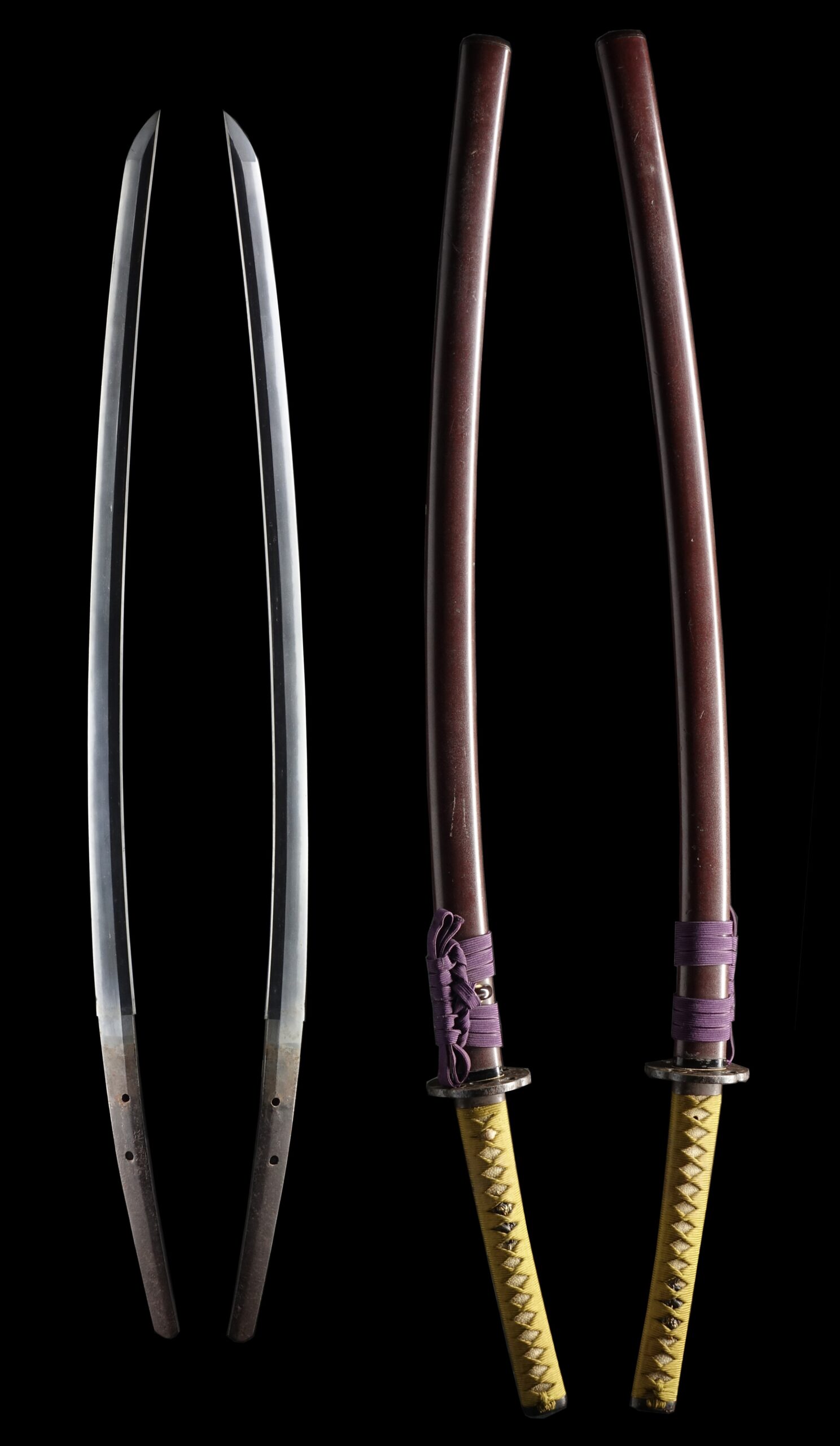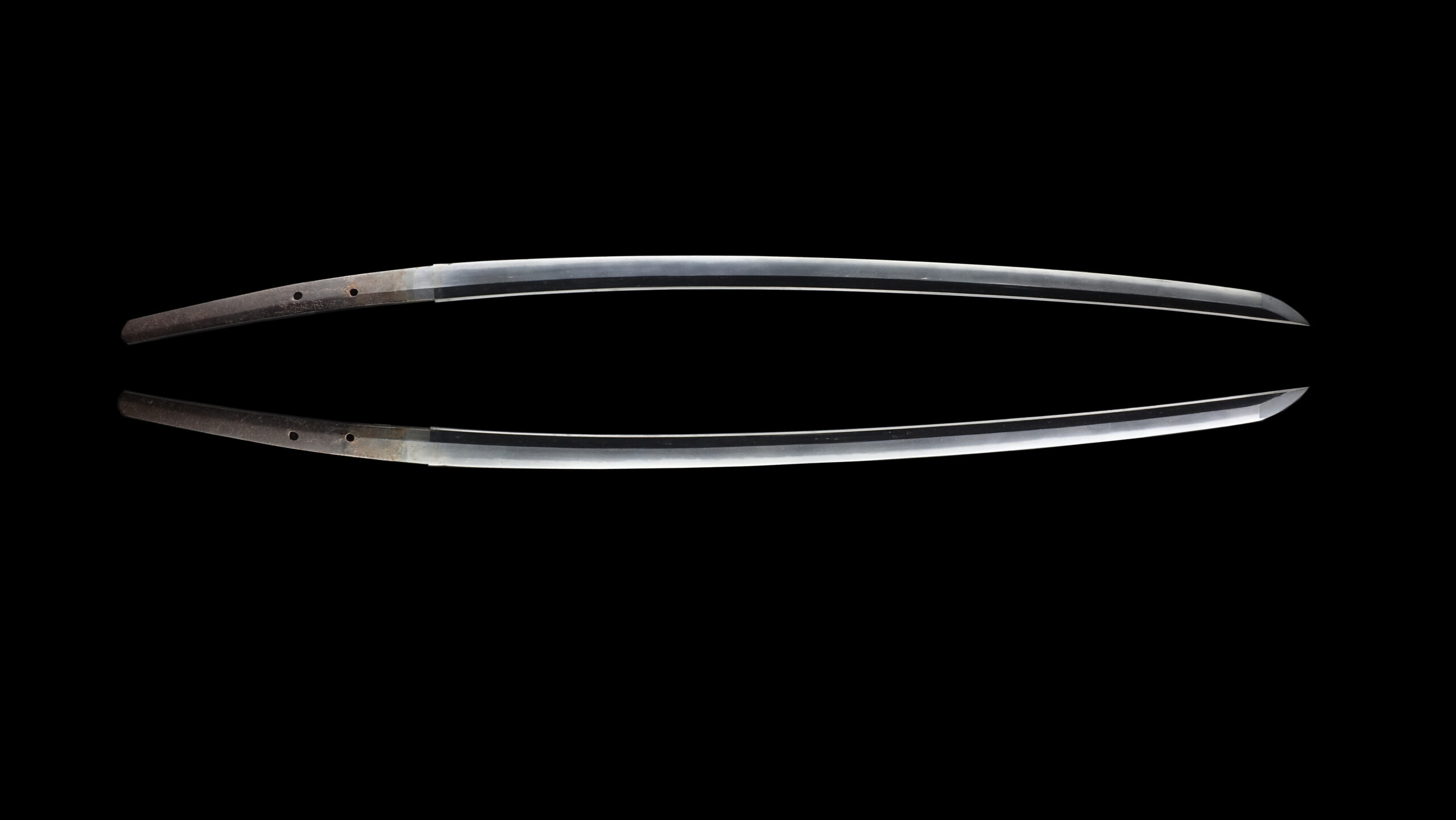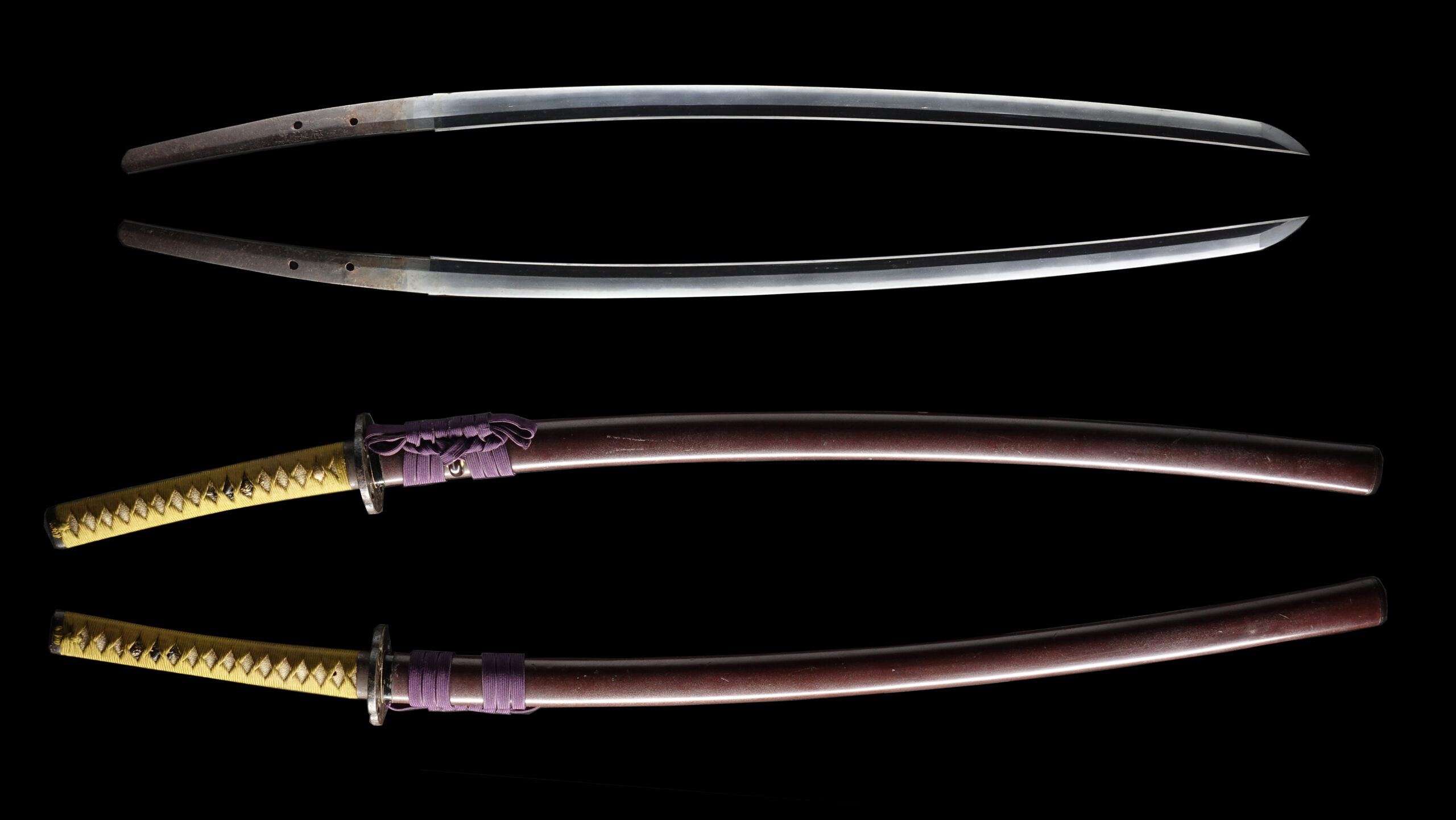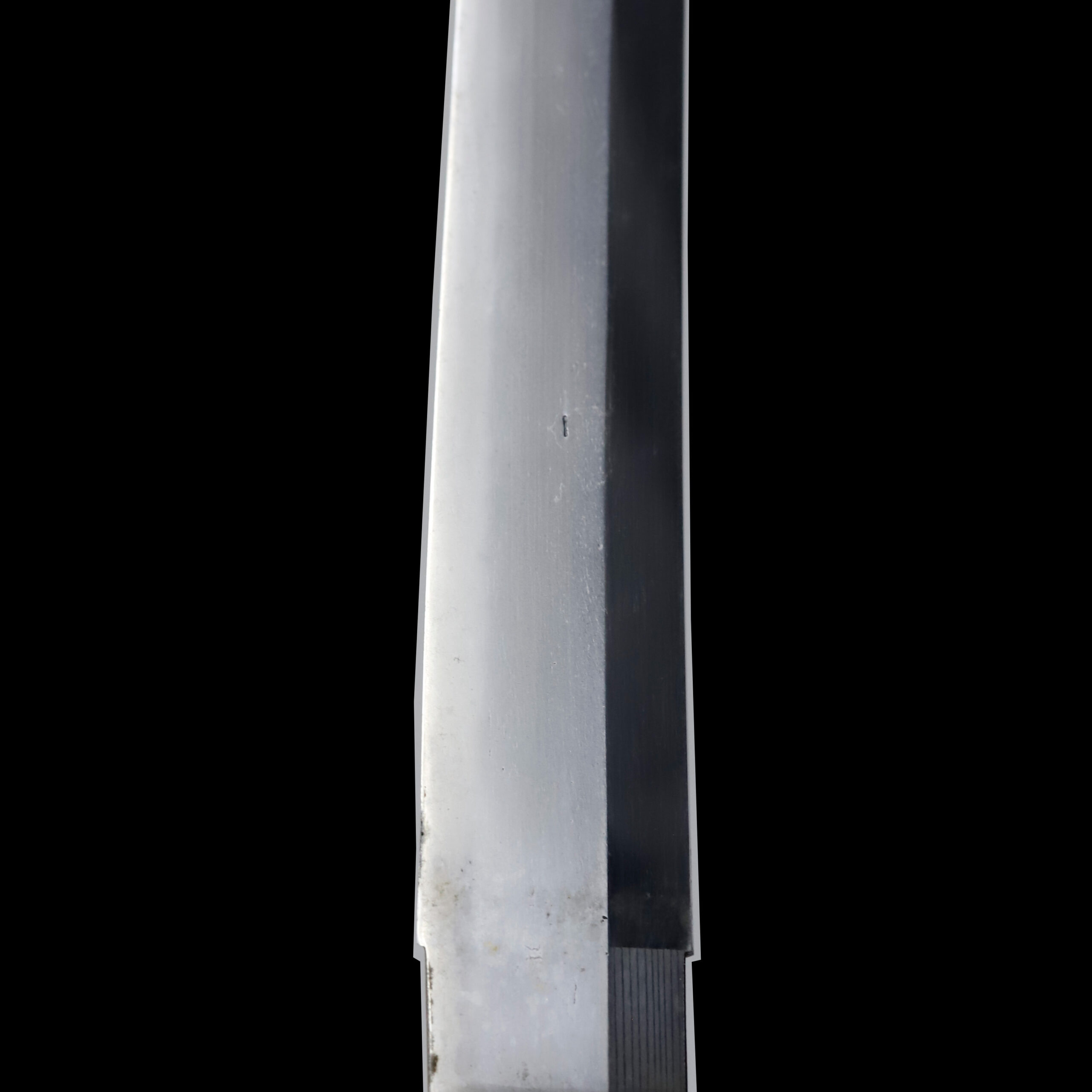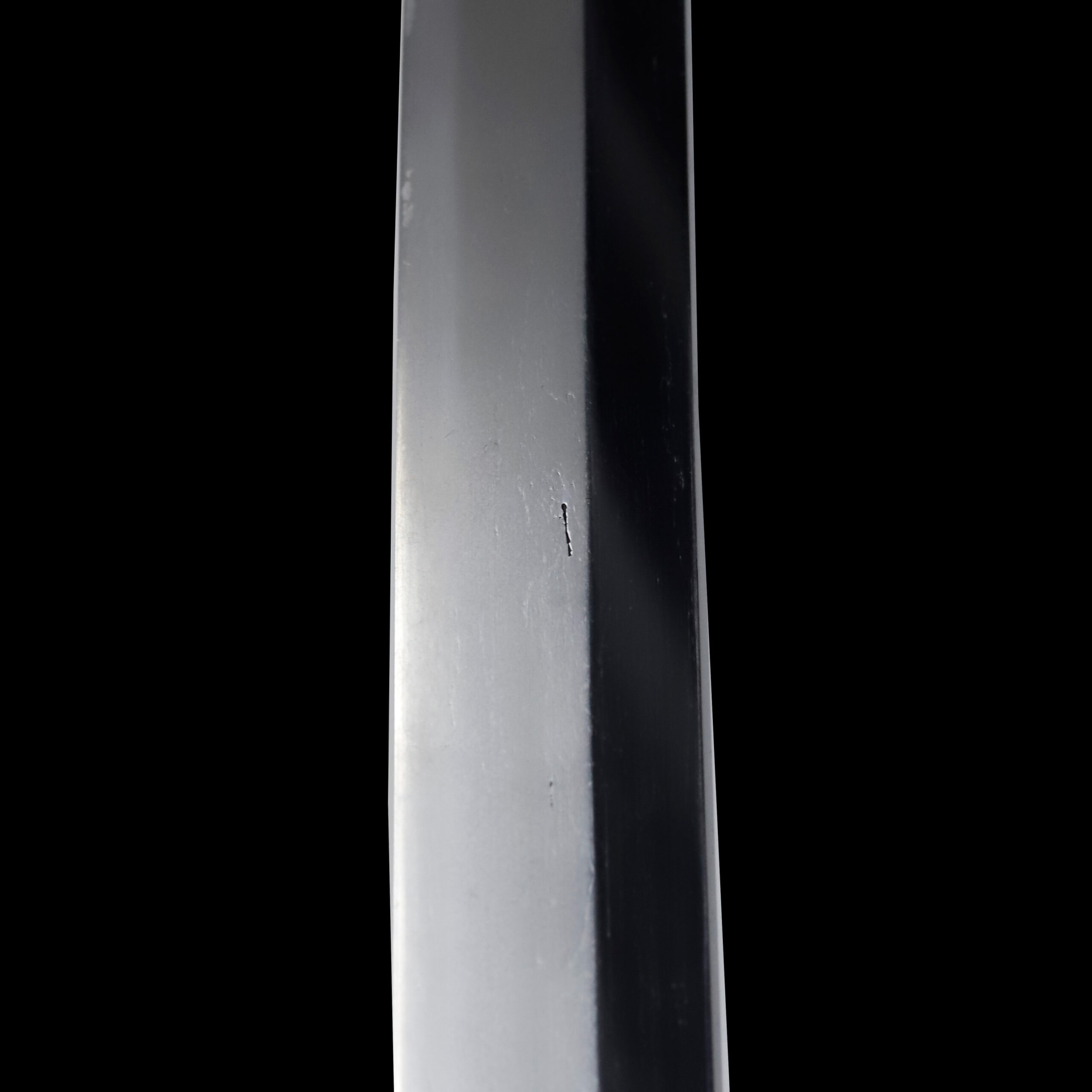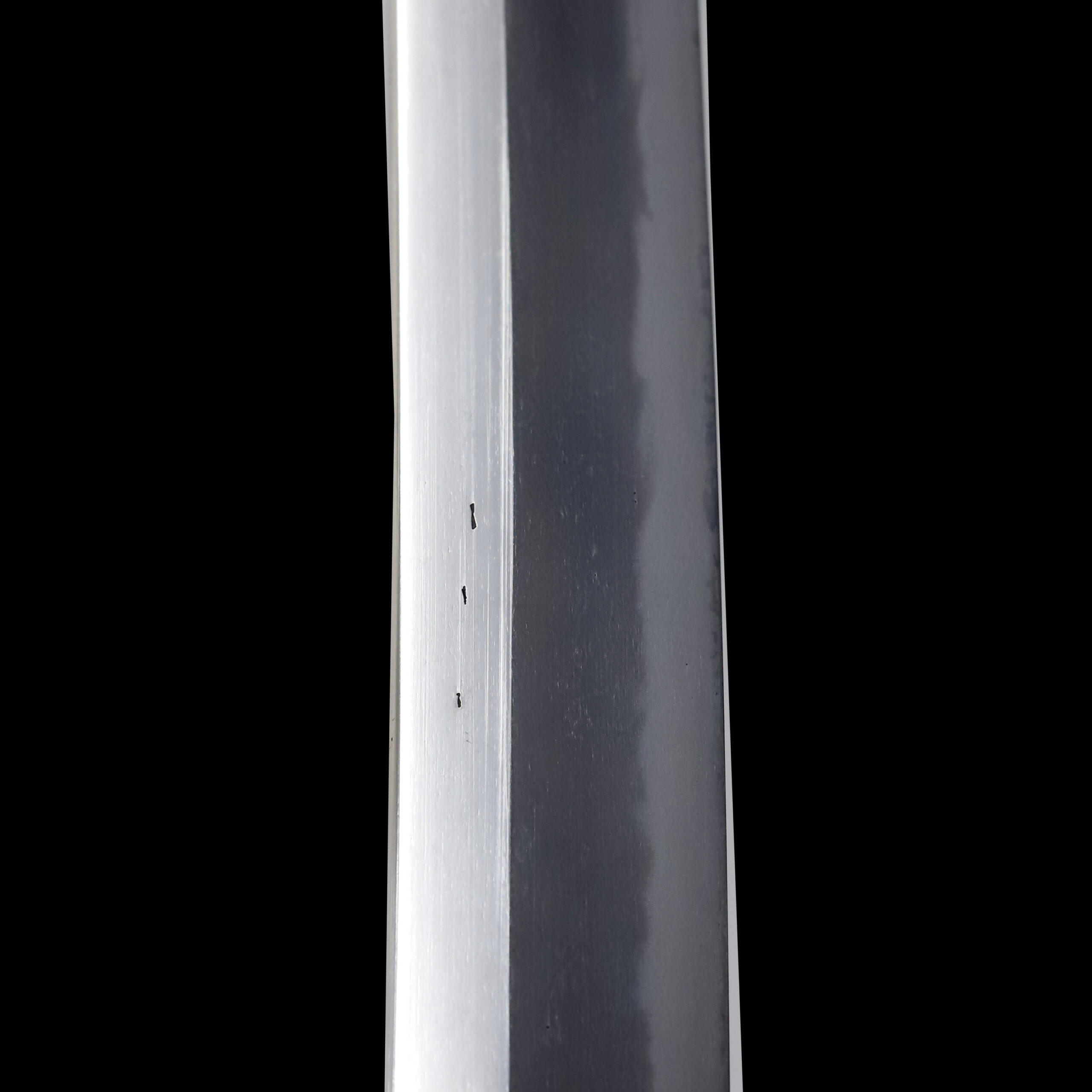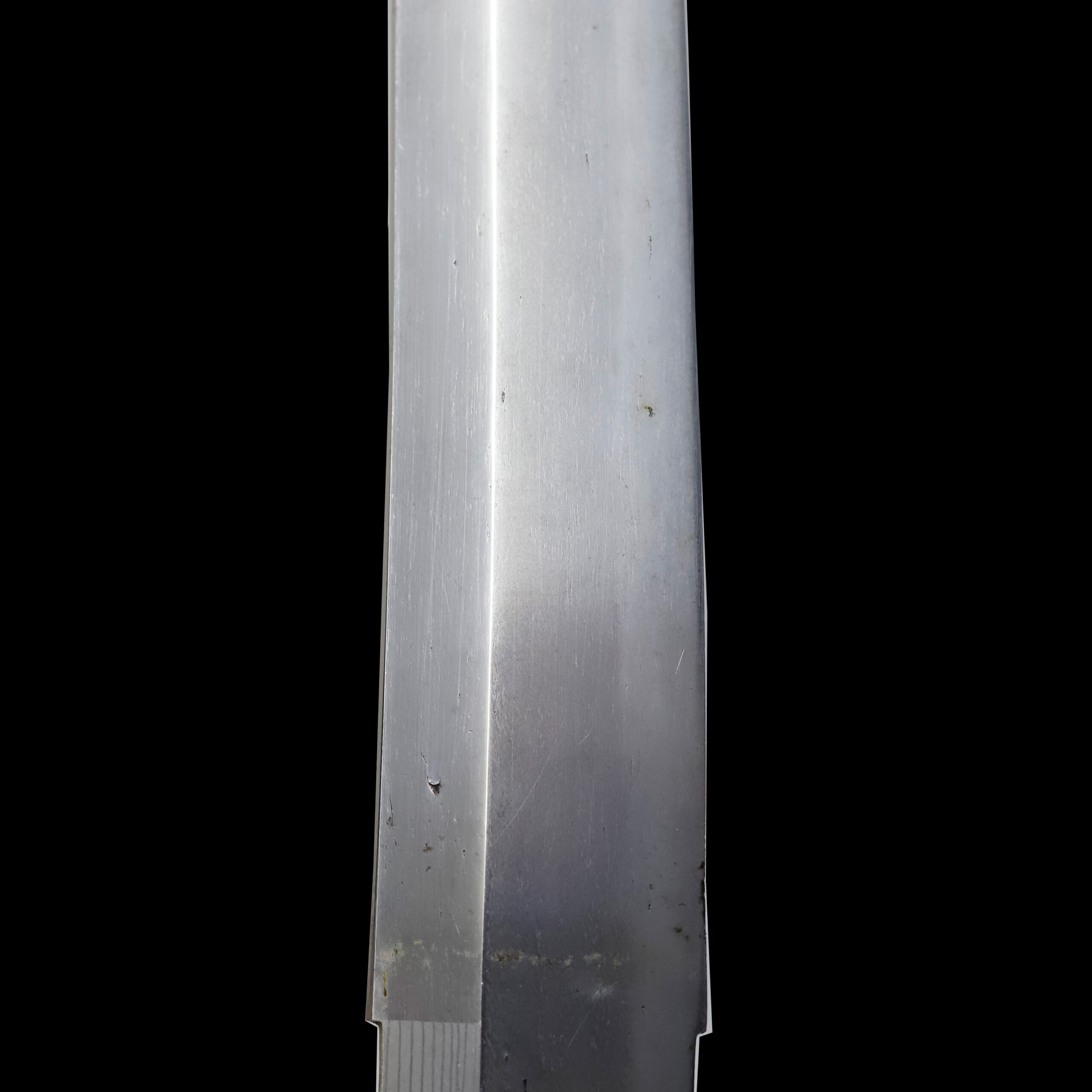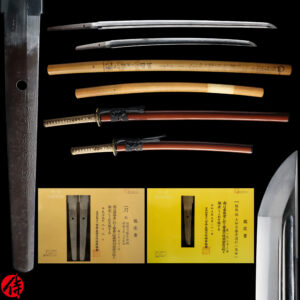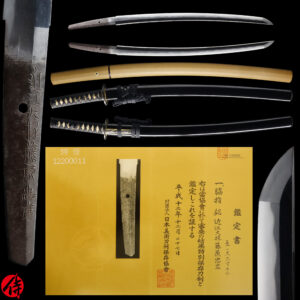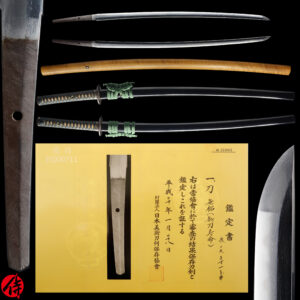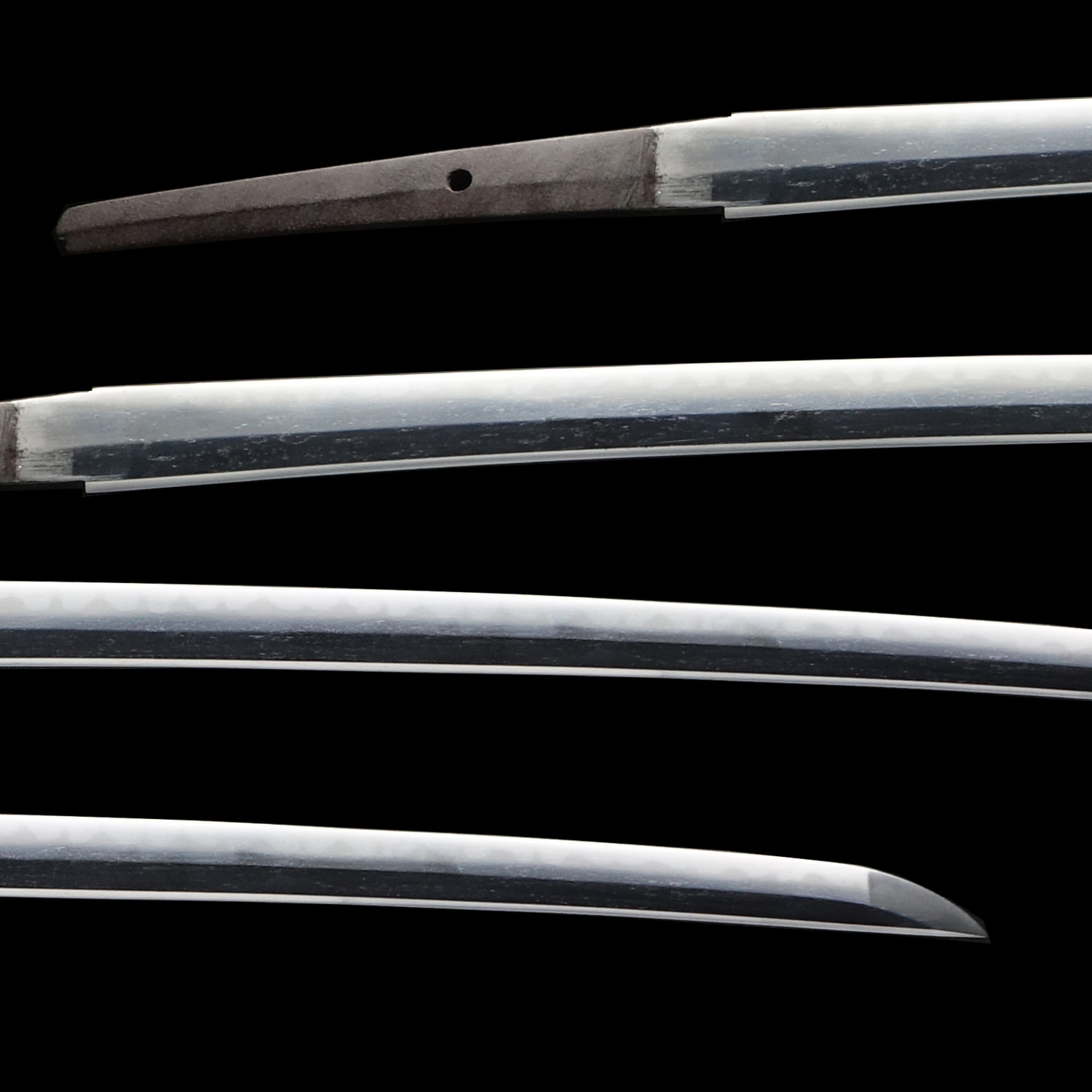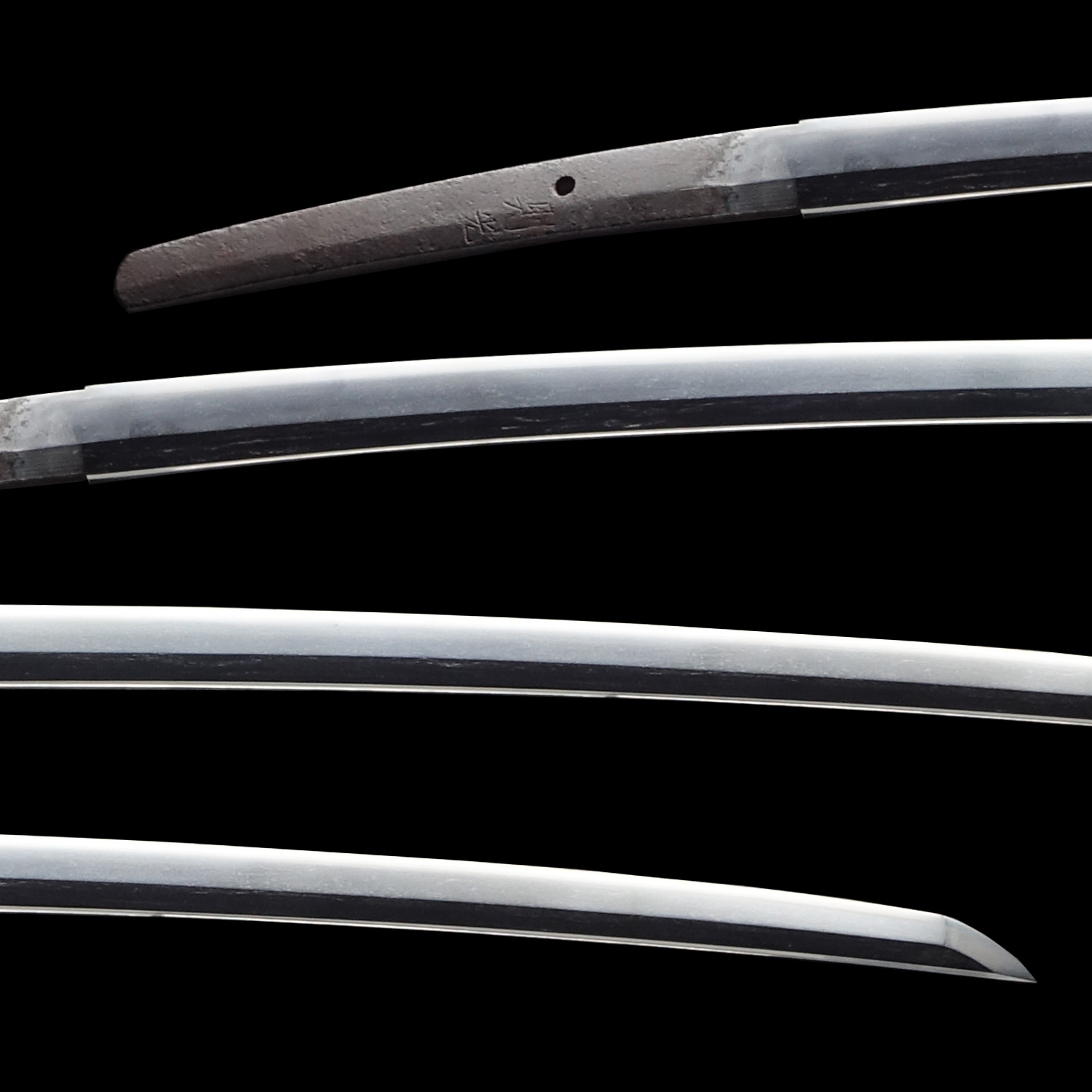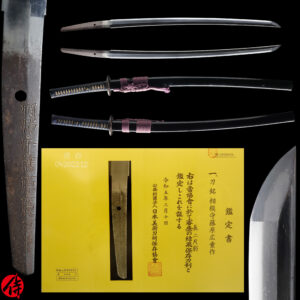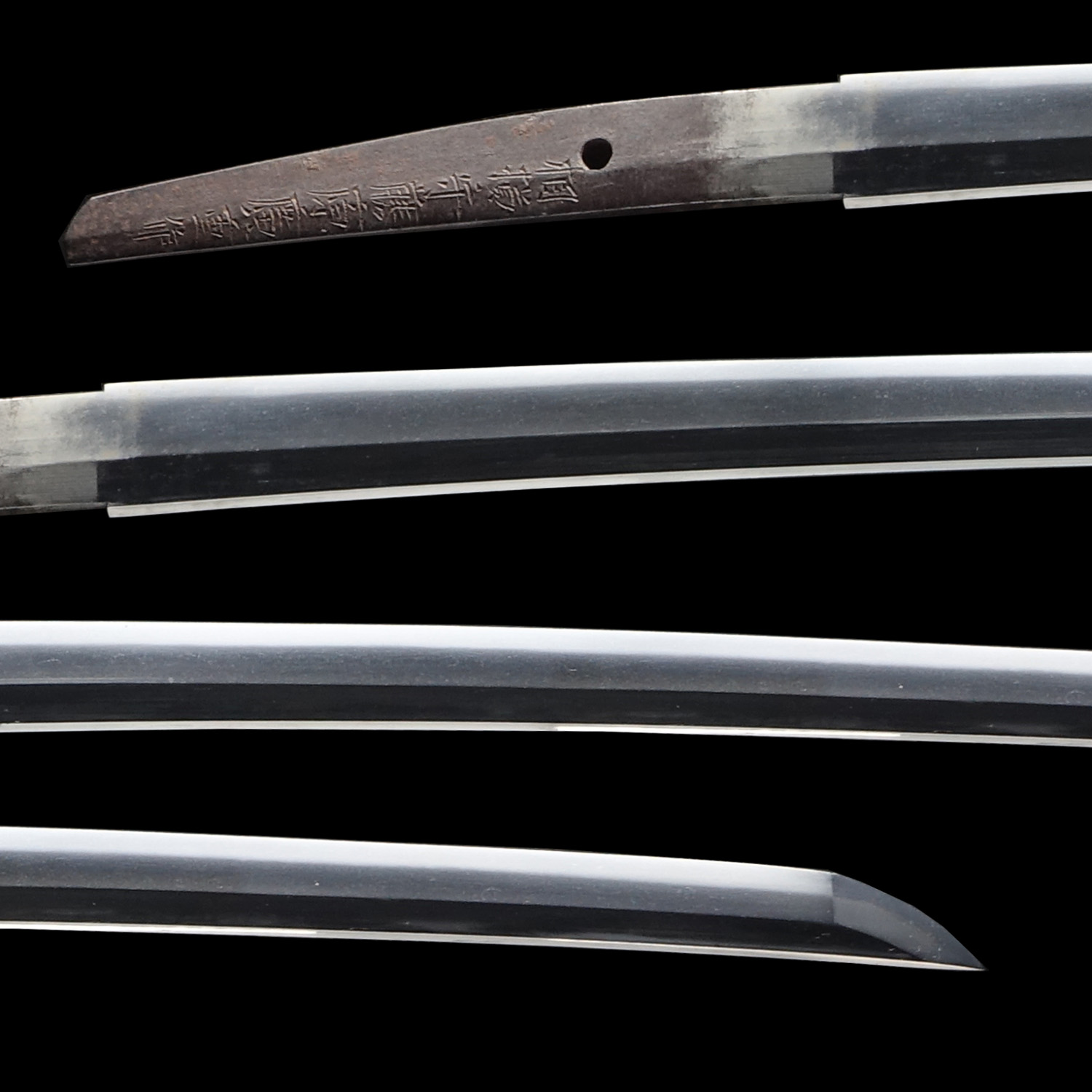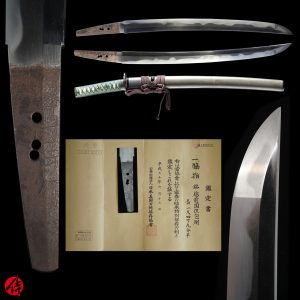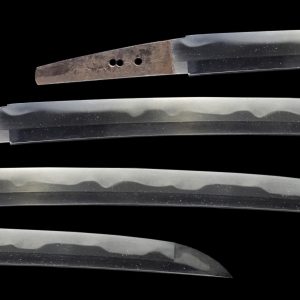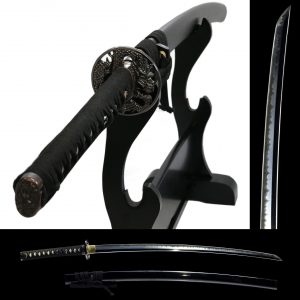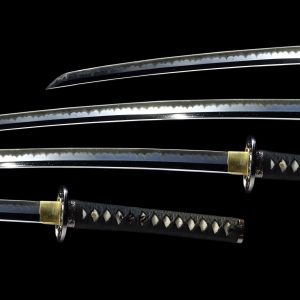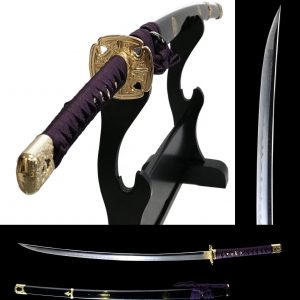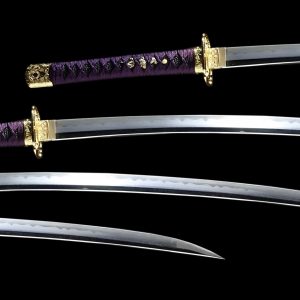Antique Japanese Sword Katana Signed by Kanabo Nobukiyo with NBTHK Hozon Certificate
【Description】
Summary
This blade was signed by Nobukiyo (延清), who was active during the Late Muromachi period (1532-1555). He belonged to Kanabo (金房) school, according to the NBTHK’s appraisal. Kanabo (金房) school flourished in the late Muromachi-Azuchi Momoyama Period (Mid-Late 16th century). It is said that Kanabo school was founded in the Dai-Ei era (1521-1527: the late Muromachi period) by Kanabo Masanaga, an offspring of a member of Tegai school in Yamato region(today’s Nara prefecture).
The swordsmiths who belonged to Kanabo school made blades for Sohei, Buddhist warrior monks, and Samurai in the area during the warring state period called SENGOKU JIDAI when there were so many rivalries and civil wars among feudal lords. One of the most renowned swordsmiths in Kanabo school is Kanabo Masatsugu (金房政次). According to Kokin Kaji Biko (古今鍛冶備考), a book about famous Japanese swords written during the Edo period, a spear forged by a member of Kanabo school is listed as one of the three most renowned spears. This spear is called Nihongo (日本号).
About Tegai school
There were five prestigious schools, including Tegai, during the Kamakura-Nanbokucho period. They are called Yamato Goha(大和五派); Senjyuin(千手院), Tegai(手掻), Taima(当麻), Hosho(保昌) and Shikkake school. They served politically powerful monks and temples in Nara, such as Todaiji temples.
They were initially forging swords for military monks who became powerful due to the government’s policy. Monks needed many weapons as there were many political rivalries between influential temples, and they needed strong weapons like swords to protect themselves. During this time, Tegai school or other Yamato sword schools met the requests from monks. They also forged blades for Samurai hired by those monks during their heyday.
Tegai school belonged to YAMATO DEN, the longest history among GOKADEN and five Japanese sword forging techniques. The blades forged by swordsmiths residing in Yamato region are generally called Yamato Mono.
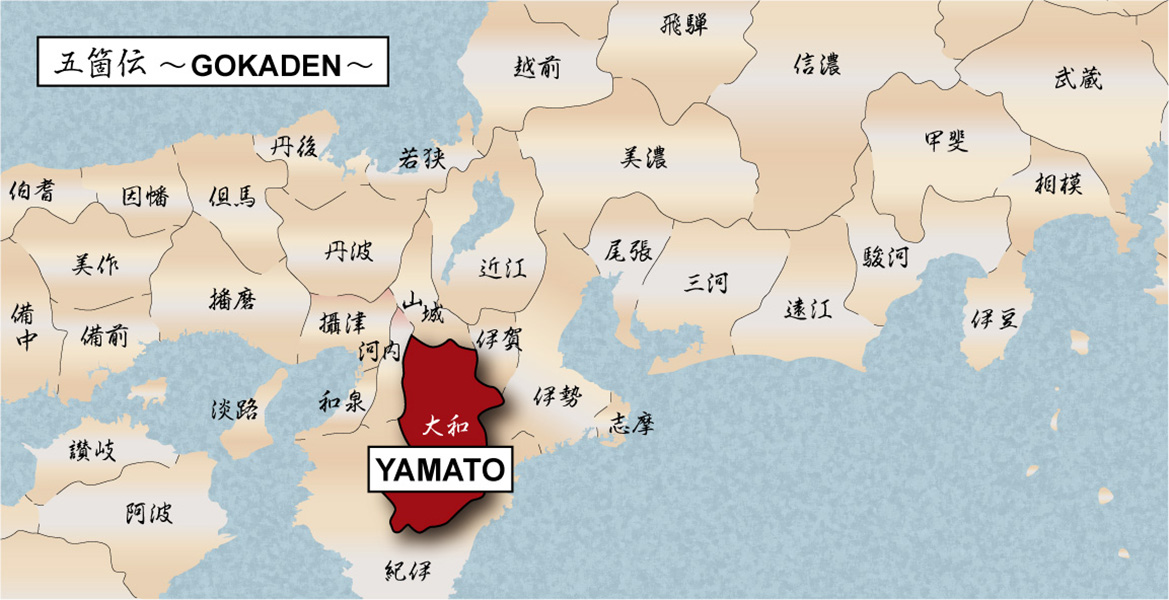
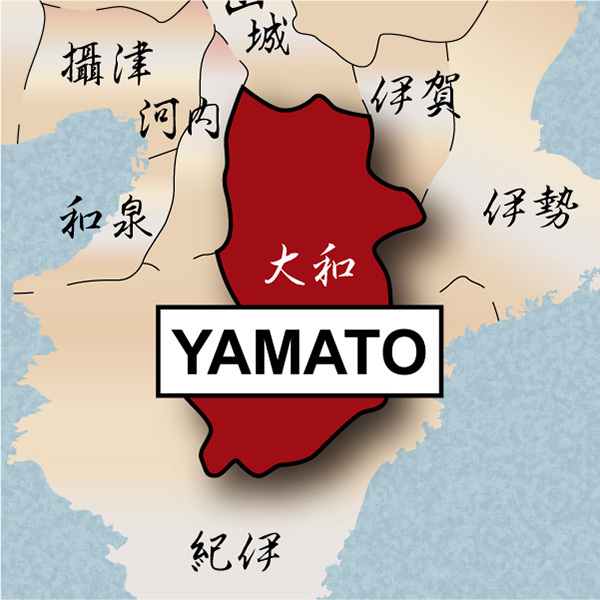
This blade is appraised as a Hozon Touken (保存刀剣) issued by NBTHK (Nihon Bijutsu Touken Hozon Kyokai: 日本美術刀剣保存協会). This authentication paper was only given to authentic Japanese swords, well preserved and high quality with artistic value.
*Please keep in mind that there are a few Kitae Kizu on this blade. If you like to see the detailed condition, please feel free to contact us.
【Blade】
Cutting Edge Length (Nagasa): 68.3 cm ( 26.9 inches)
Curvature (Sori): 1.81 cm (0.71 inches)

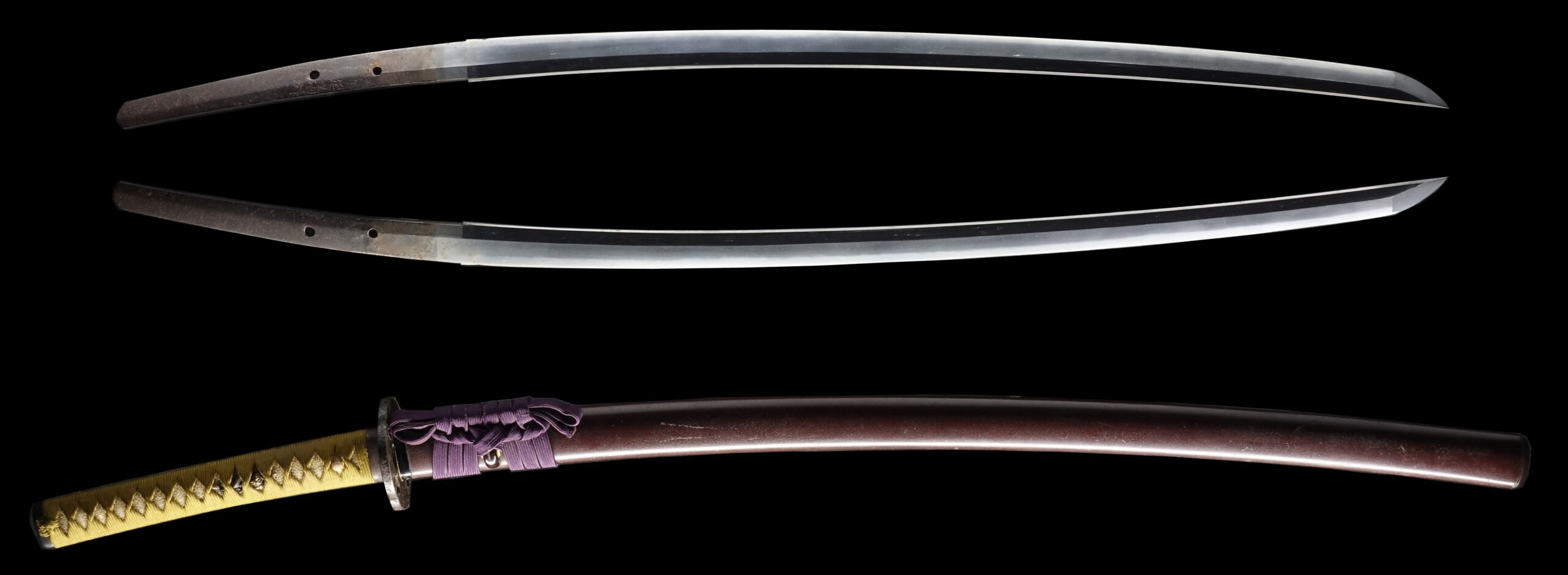
Hamon:
The crystalline structure which forms along the cutting edge of a blade as a result of the hardening process.
Jimon (Jihada):
Visible steel surface pattern created by folding and hammering during forging process.
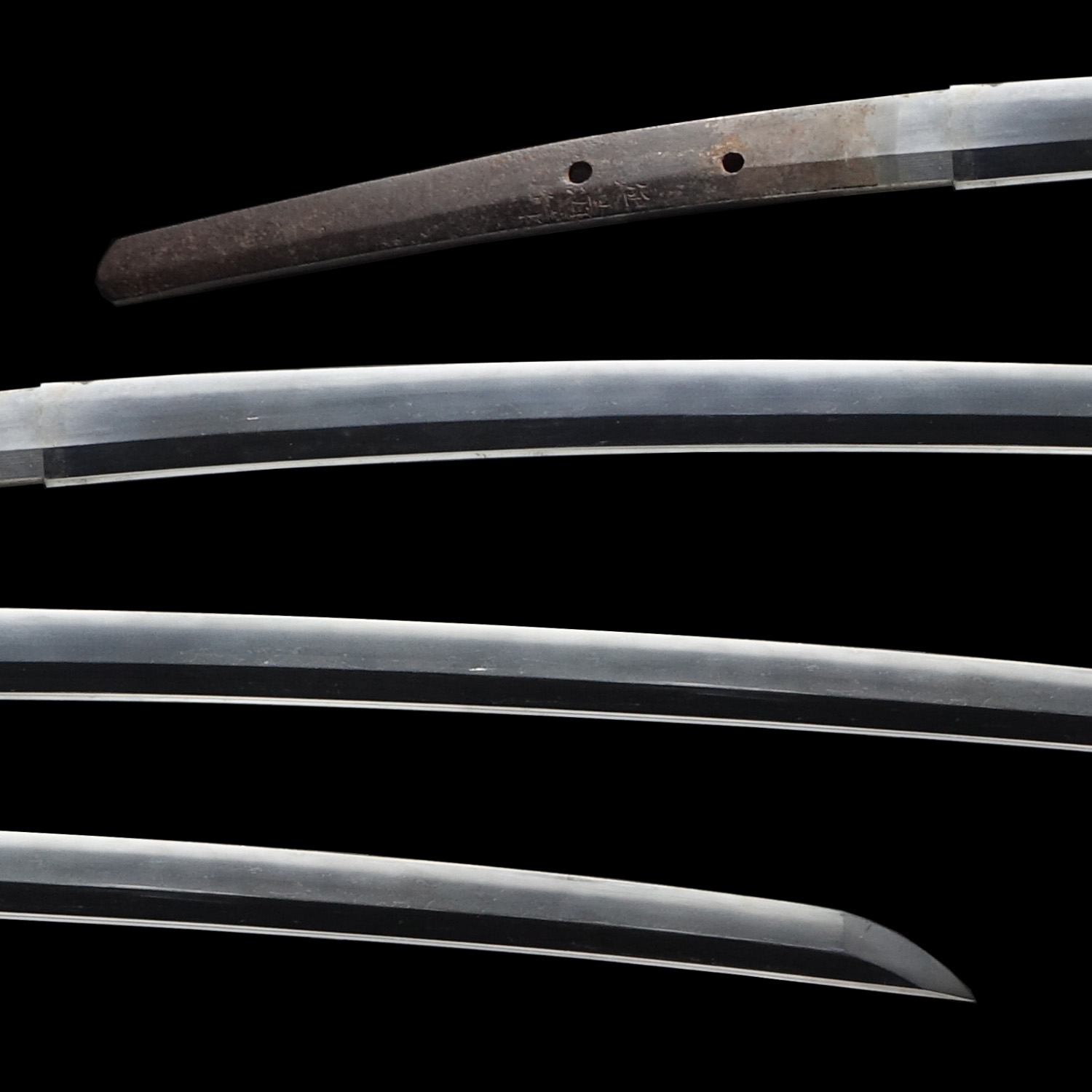
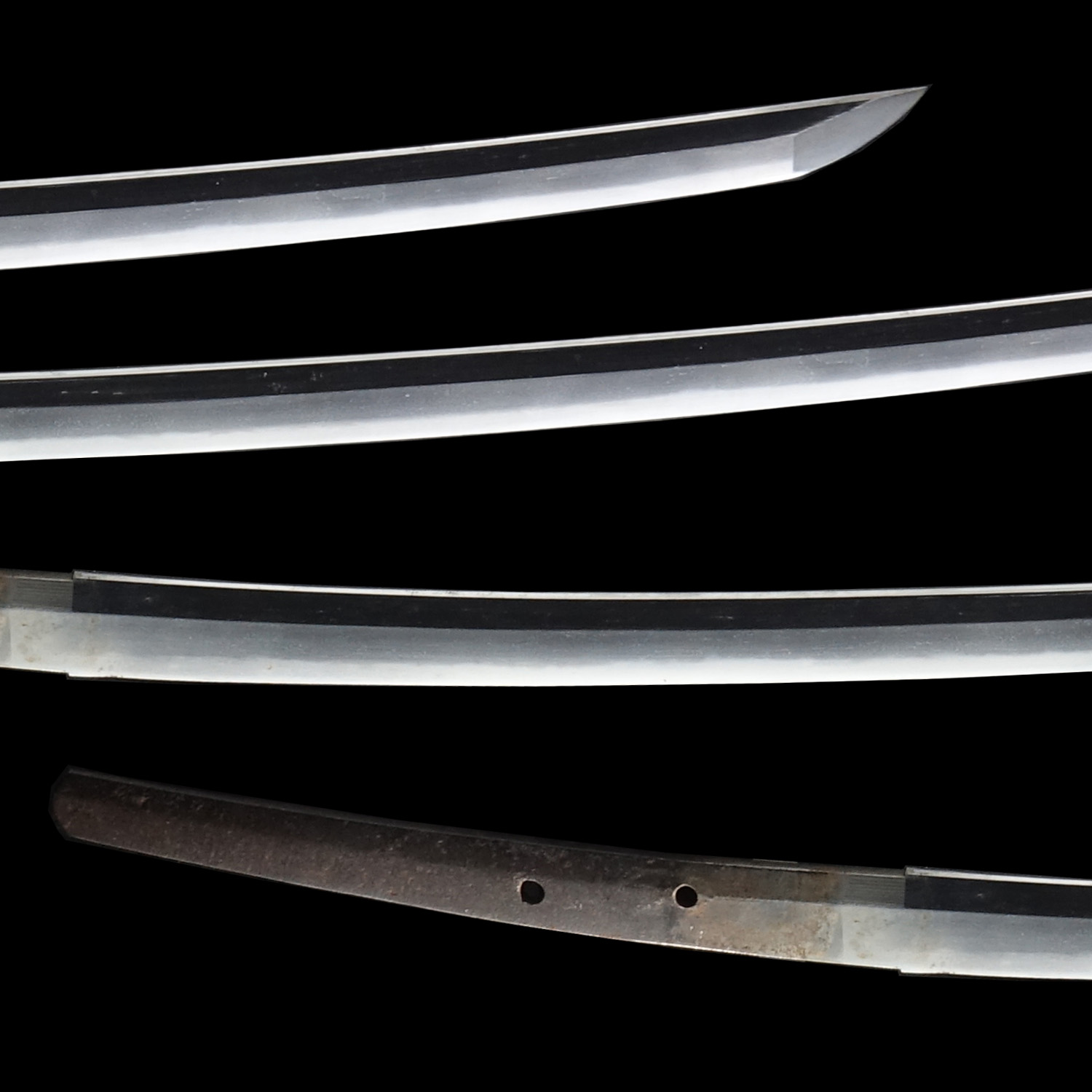
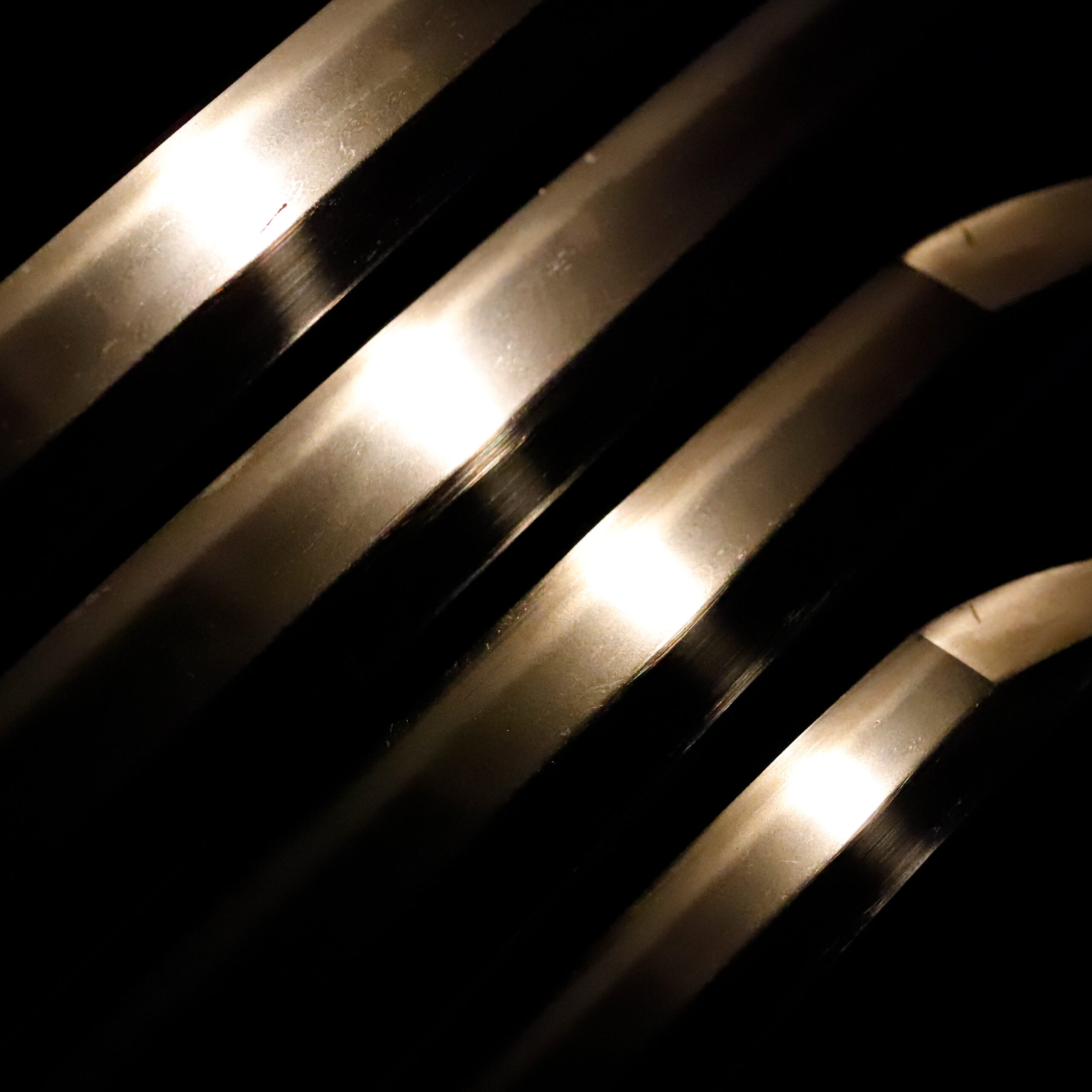
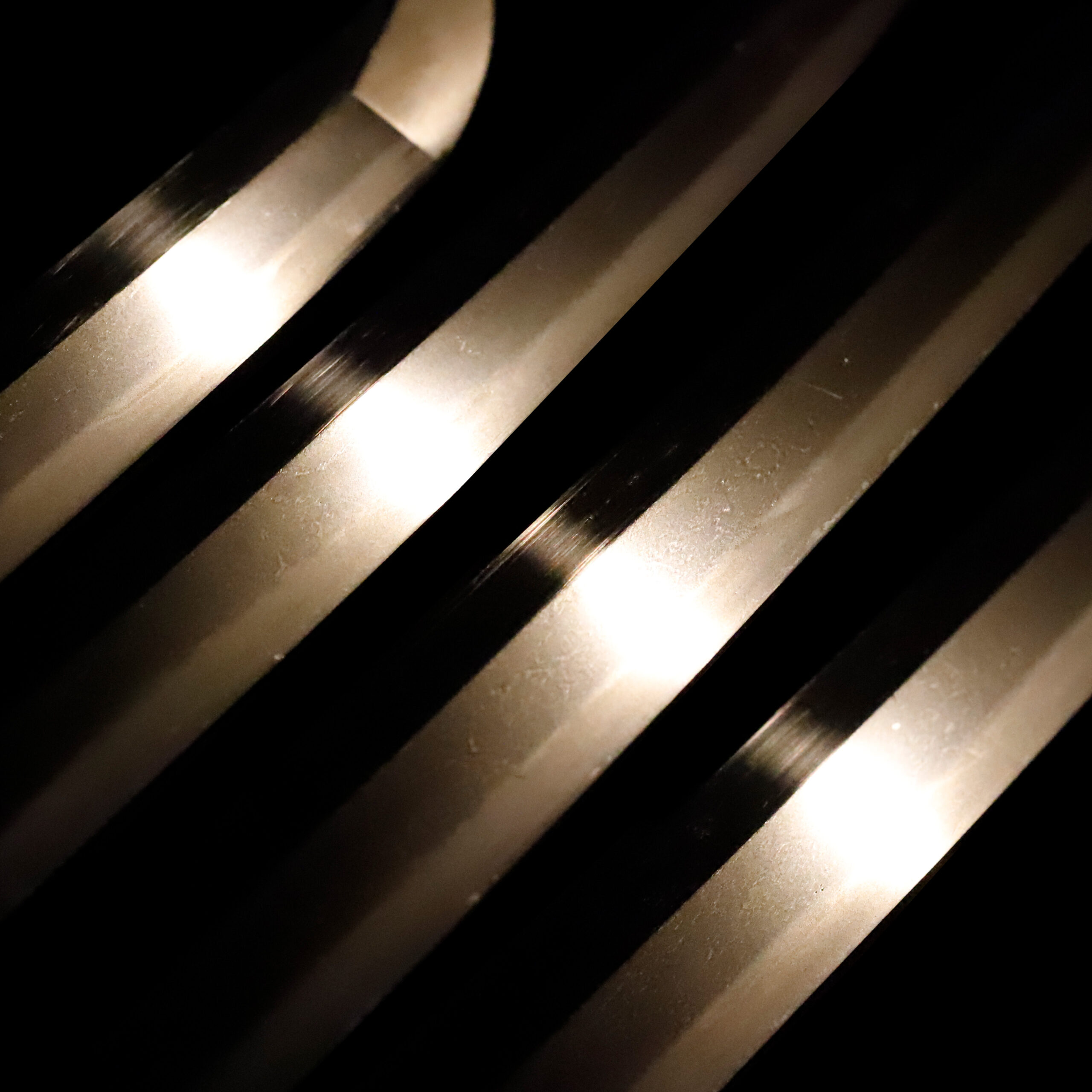
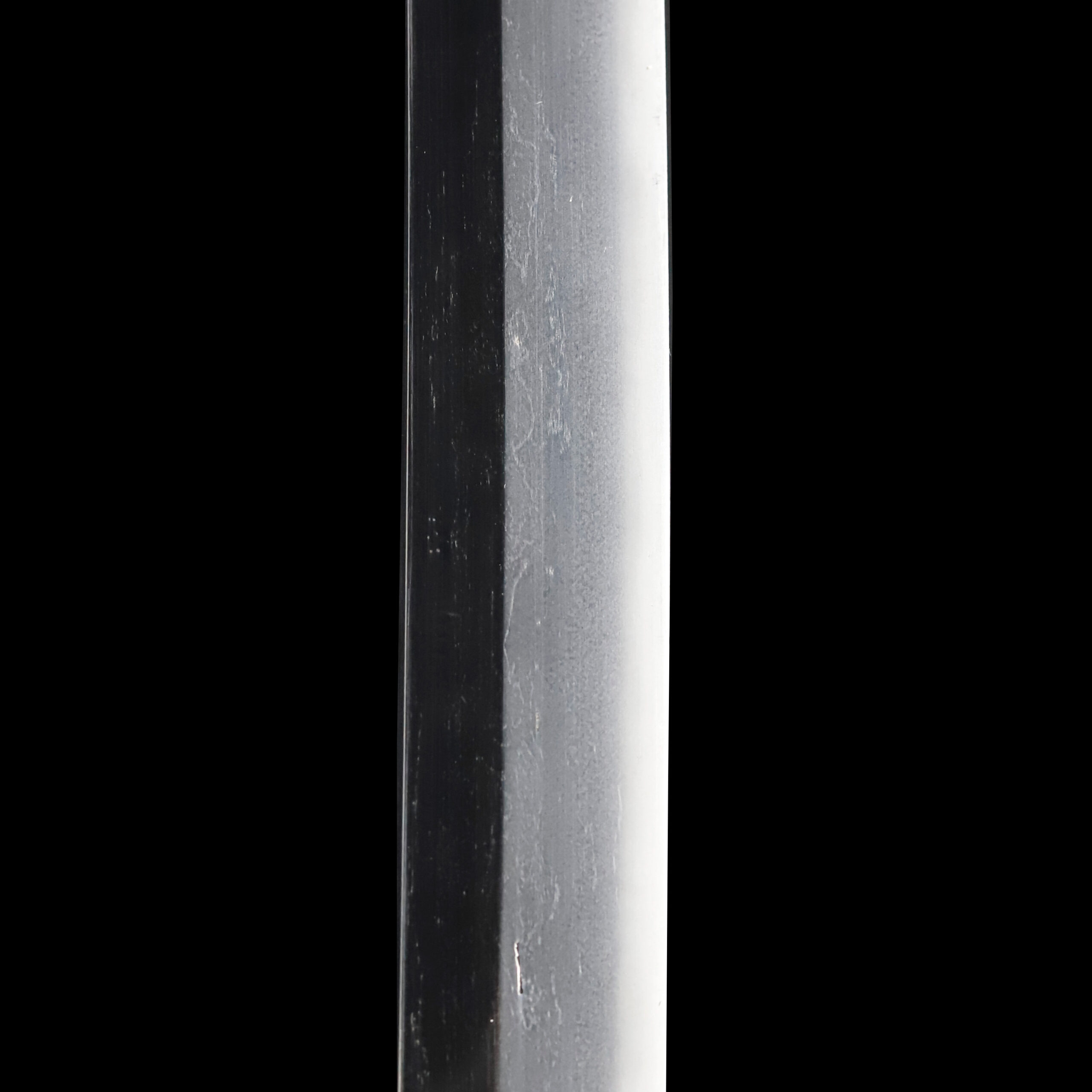
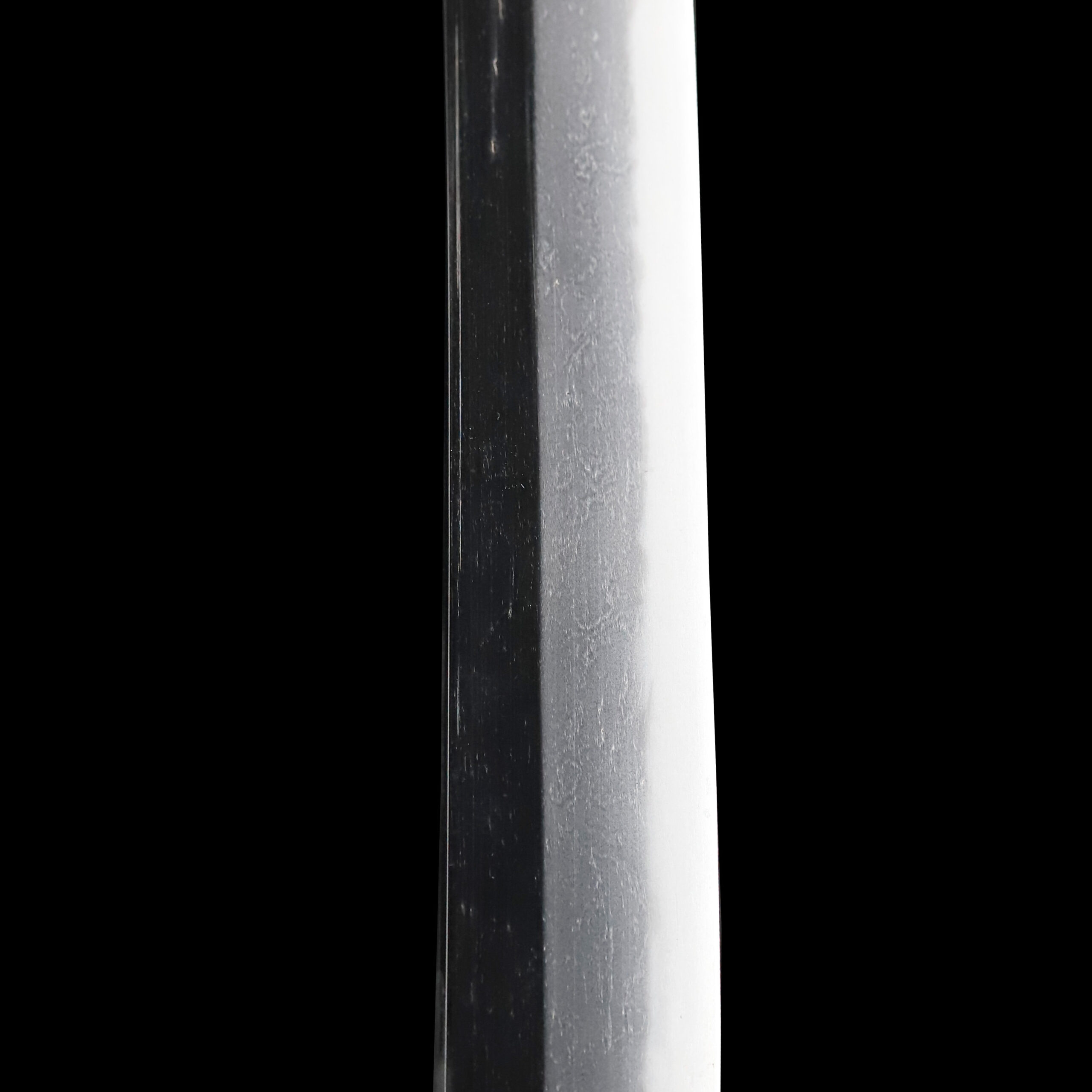
Nakago: Nakago is the tang of the Japanese sword.
Japanese swordsmiths left the black rust on the tang because it prevents red rust while the tang is in its handle. And the discoloration of the tang was created over time, and it is a great indicator for a Japanese sword specialist to estimate when the sword was forged.
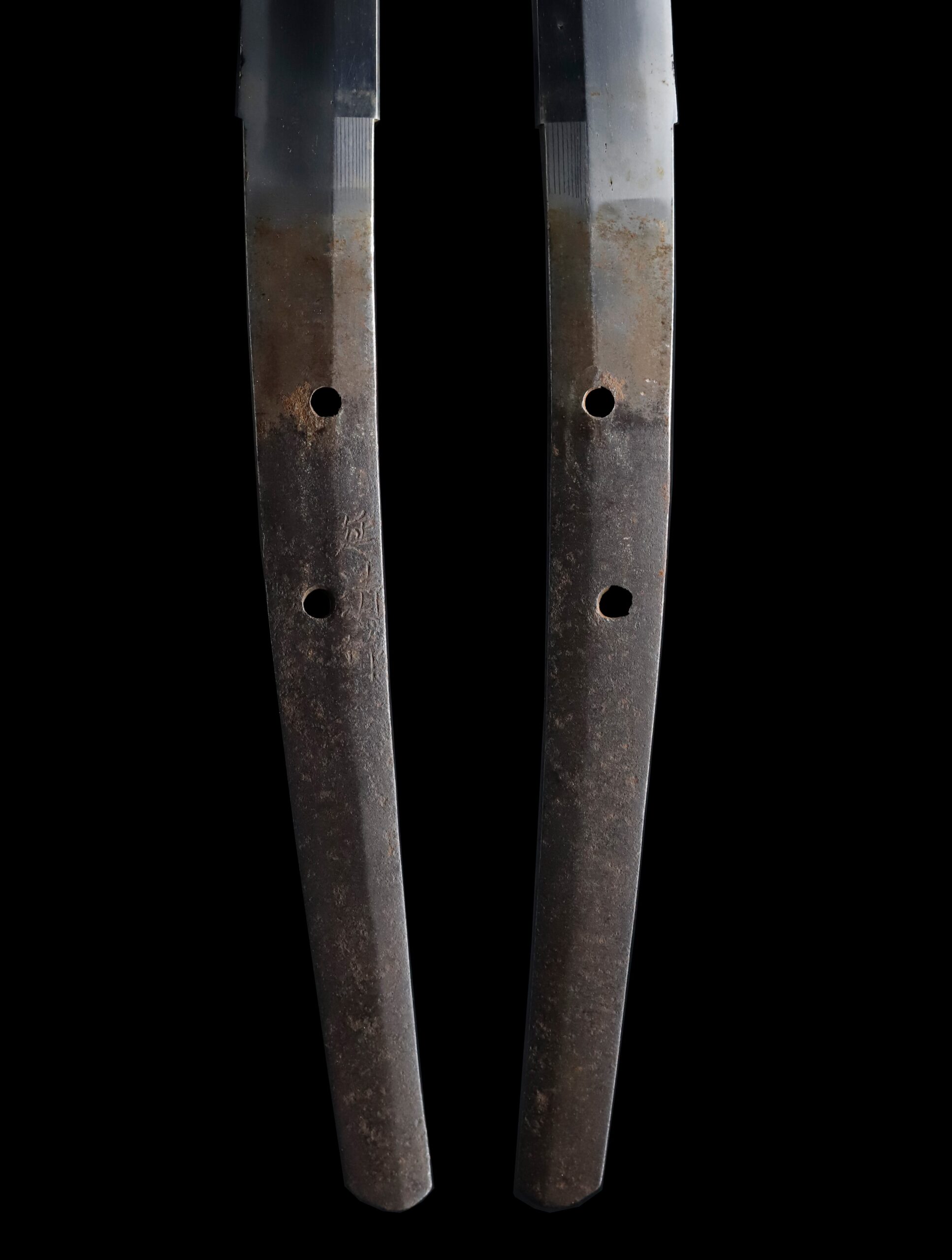
Koshirae: Koshirae is the mounting of the Japanese sword. There are several parts that consist of Koshirae such as Saya (Scabbard), Tsuka (Handle), Tsuba (Handguard).
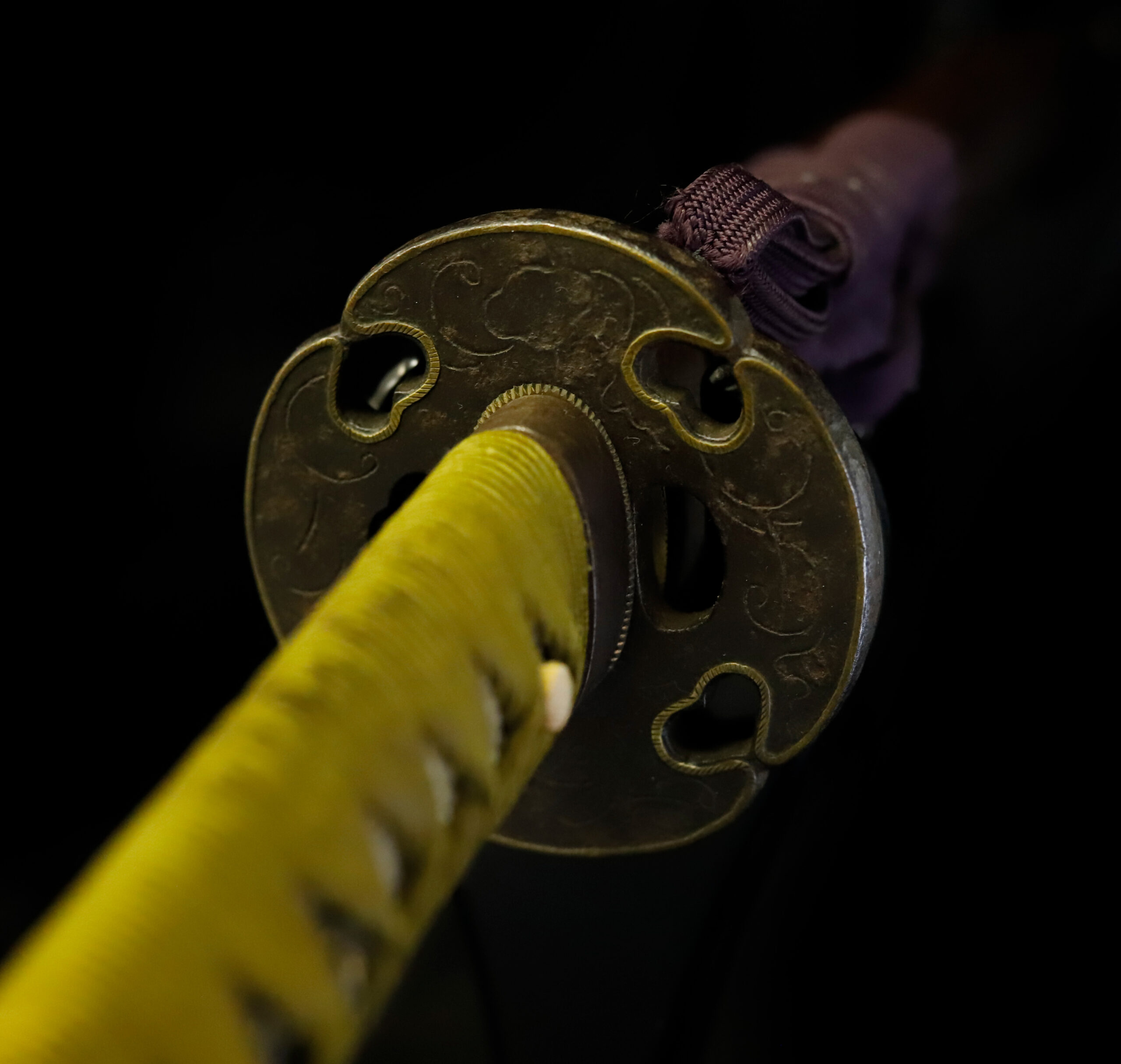
Fuchi-Kashira: A pair of matching sword fittings that cover the upper and bottom parts of its sword hilt.
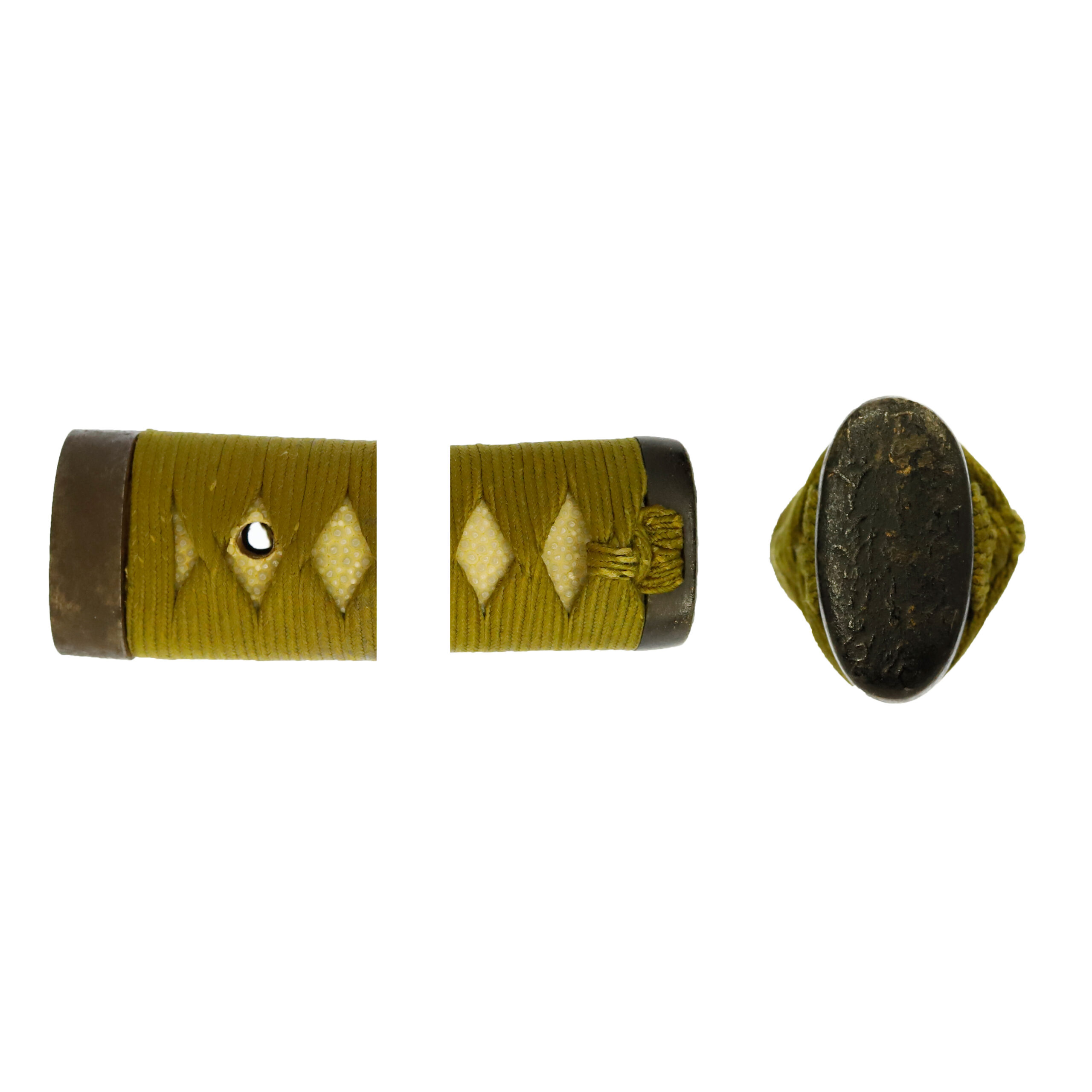
Tsuka and Menuki: Tsuka is the handle of the Japanese sword and Menuki is its decoration.
You would find a figure of the dragon in the gaps of the Tsukamaki thread. Although it has partially faded due to aging, we could see the traces that golden paint was applied to these dragons. Initially, the dragon was an imaginary creature found in ancient foreign traditions and myths. Furthermore, it is regarded as a symbolic beast of auspicious signs. Its body is likened to nine animals: antlers are deer, the head is a camel, eyes are demons, the neck is a snake, the belly is the Mizuchi (蛟, a mythical animal in Japan that looks like a snake and has a horn and four legs), scales are fish, claws are falcons, palms are tigers and ears are cows. It was thought that the dragon would reign at the top of all animals because of its odd-looking appearance.
If you focus on these dragons’ hands, you would find that they bring a ball-shaped object in their hands. This item is the Nyoi Houju (如意宝珠, Cintāmaṇi), a fantasy jewel that fulfills any desire and gives out treasure, clothes, food, and drinks. Moreover, it heals illness and suffering, removes evils, purifies muddy water, and prevents disasters. It is said this magical item is taken from the brain of the dragon king. There are lots of dragon-designed sword mountings. It shows that many Samurai cherished this dignified beast motif.
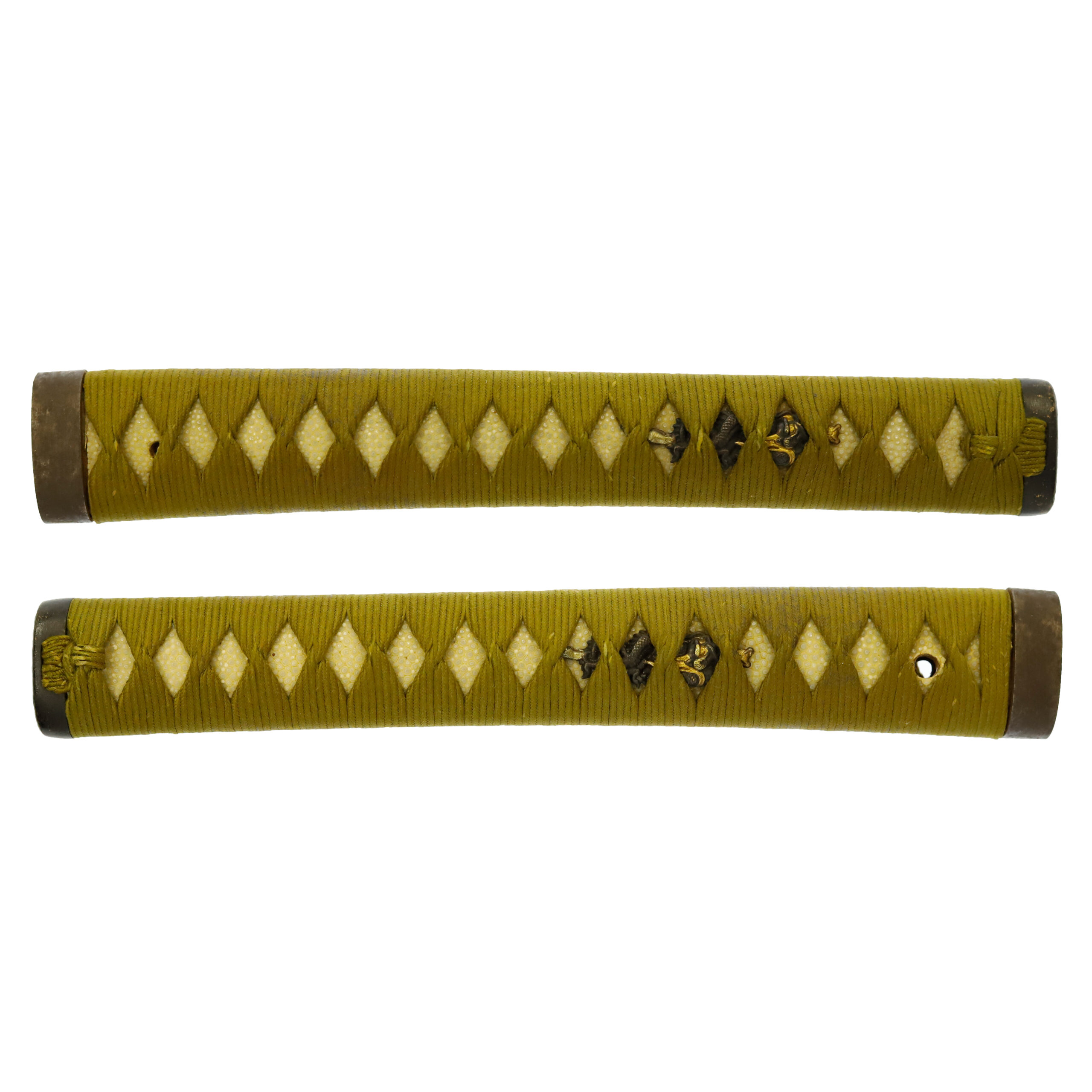
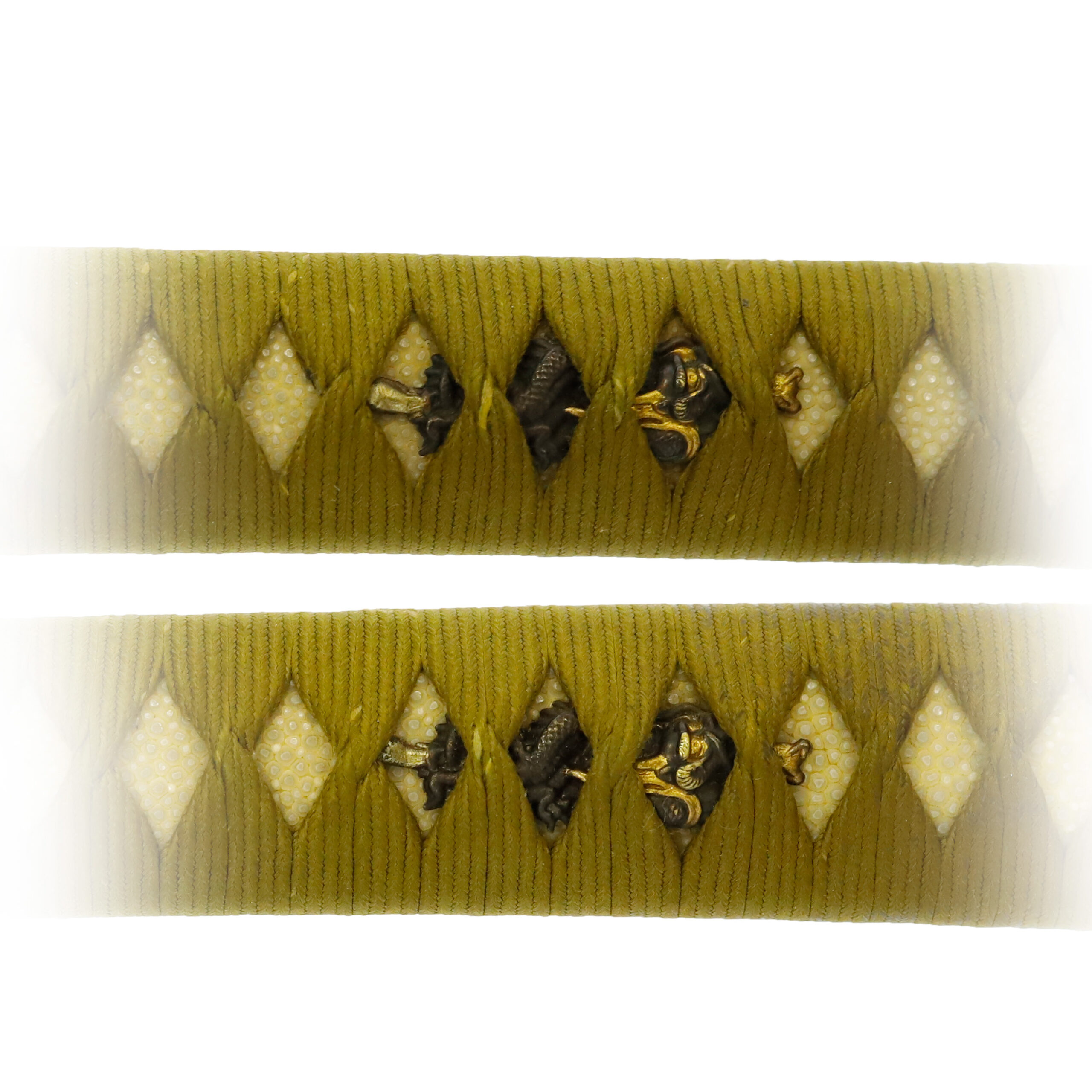
Tsuba and Habaki: Tsuba is the handguard for the Japanese Sword and Habaki is the equipment to make the blade not touch its scabbard inside. It prevents the blade from getting rusty and chipped.
This Yotsu-Mokkou (四ツ木瓜) shaped Tsuba is decorated with brass inlay. The rope pattern brass inaly is placed on the edge part of this Tsuba. Due to its appearance, we estimate this Tsuba could be categorized as the Heianjo-style Tsuba. Please note that there is no proof. We would like to propose a possibility here.
This style of Tsubas was established in Yamashiro (山城, today’s Kyoto Prefecture). According to a theory, this school was born during the reign of the sixth Shogun (将軍, general) of the Muromachi (室町) Shogunate. And its style was influenced by the tastes of the Shogun. The works of this school could be classified into two types according to their noticeable characteristics. The one is the Heanjo Sukashi Tsuba (平安城透鐔), which is generally called the Kyou Sukashi Tsuba (京透鐔). Most Tsubas have circle shapes, and motifs are engraved dynamically with openwork. The refined composition and outstanding techniques give the impression that metalworkers attached importance to the beauty of openwork more than the practicality of a Tsuba itself. Another type is the Heanjo Zougan Tsuba (平安城象嵌鐔), which is also called the Heianjo Shinchu Zougan Tsuba (平安城真鍮象嵌鐔). Shinchu (真鍮) means brass and Zougan (象嵌) means inlay in Japanese. This style inherited Ounin Tsuba’s (応仁鐔) techniques. Motifs such as Botan (牡丹, peony), Nanten (南天, nandina), or Karakusa (唐草, arabesque) patterns are inlaid with brass on circle-shaped iron Tsubas. Later, artisans started using gold, silver, and Shakudou (赤銅, an alloy of copper and gold) to create more ornate Tsuba works.
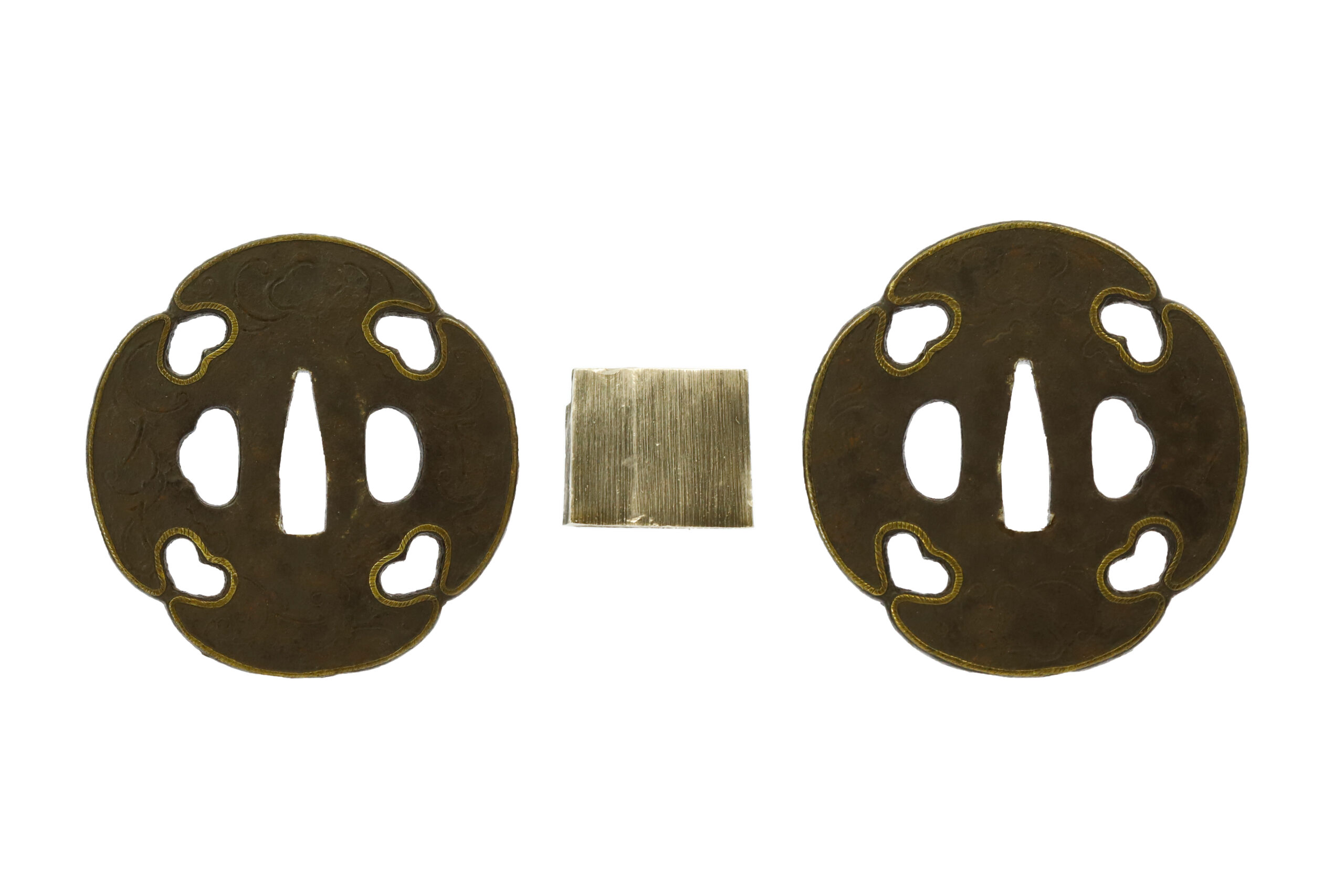
Saya: Saya is the scabbard for the Japanese sword.
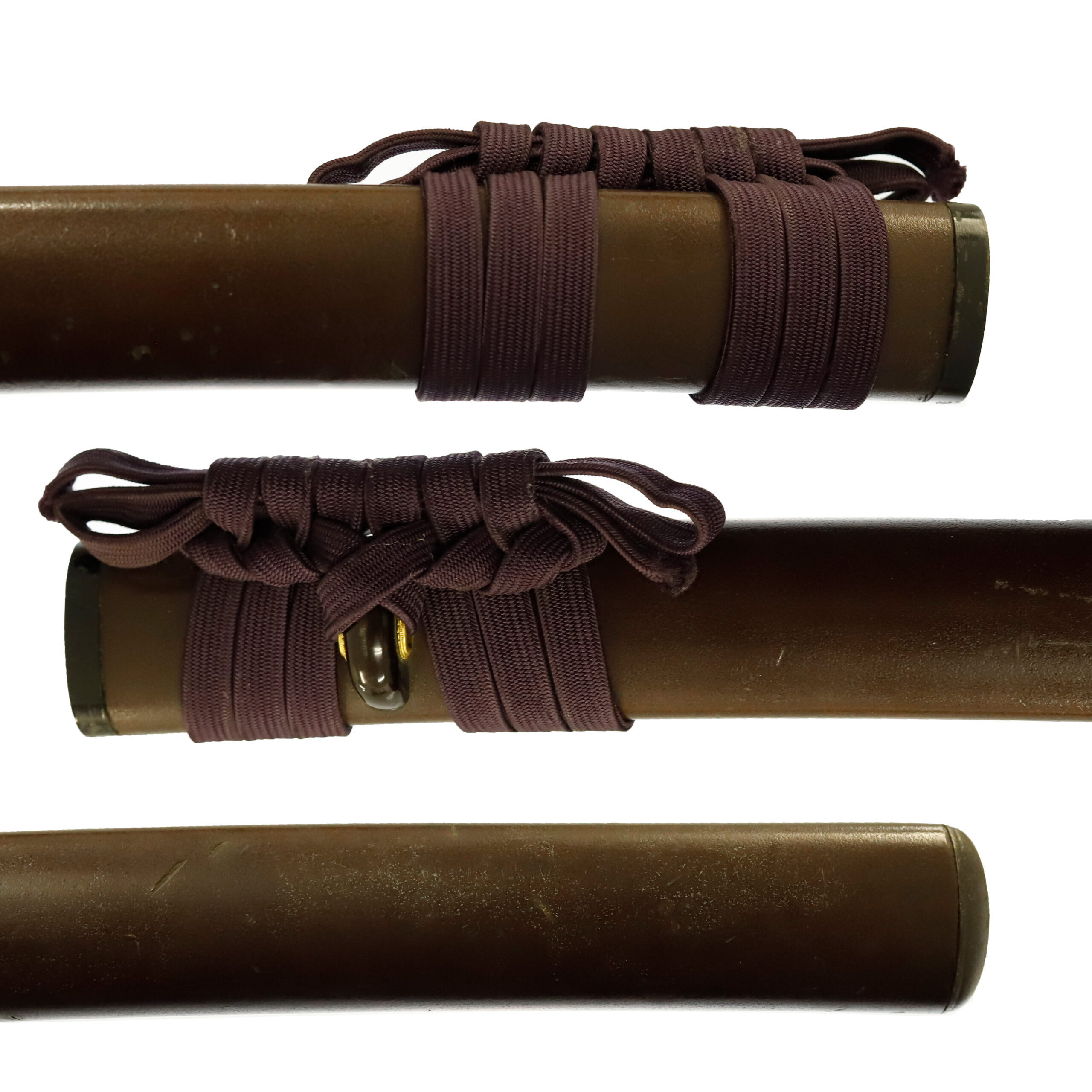
Authentication Paper: NBTHK Hozon Certificate for the blade
NBTHK, also known as Nihon Bijutsu Touken Hozon Kyokai (the Society for the Preservation of the Japan Art Sword), is one of the oldest Japanese sword appraising organizations in modern-day Japan. They authenticated the blade in June, 2023. They appraised it as Hozon Touken, the blade worth preserving for Japanese society. We are expecting to receive its authentication paper during early-mid November. The purchaser will receive this original certificate as well. We can also translate what is written into English and make a PDF file for your record if you request.
Registration Number: Aichi 15657
The Board of Education in Aichi prefecture issued a registration paper for this sword. It is called Jyu Token Rui Torokusho (銃刀剣類登録証). Bunkacho (The Agency for Cultural Affairs) acknowledges a Japanese sword with this paper as a work of art.
The sword needs to be traditionally hand-forged and made of Tamahagane carbon steel to be registered in the system. With this paper, its owner in Japan can legally own an authentic Japanese sword. Based on this registration number, we will apply for its export permit.
This paper will need to be returned to the board of education when the sword is being shipped abroad, but you can receive a copy of it. An English translation of this registration paper is available on request.
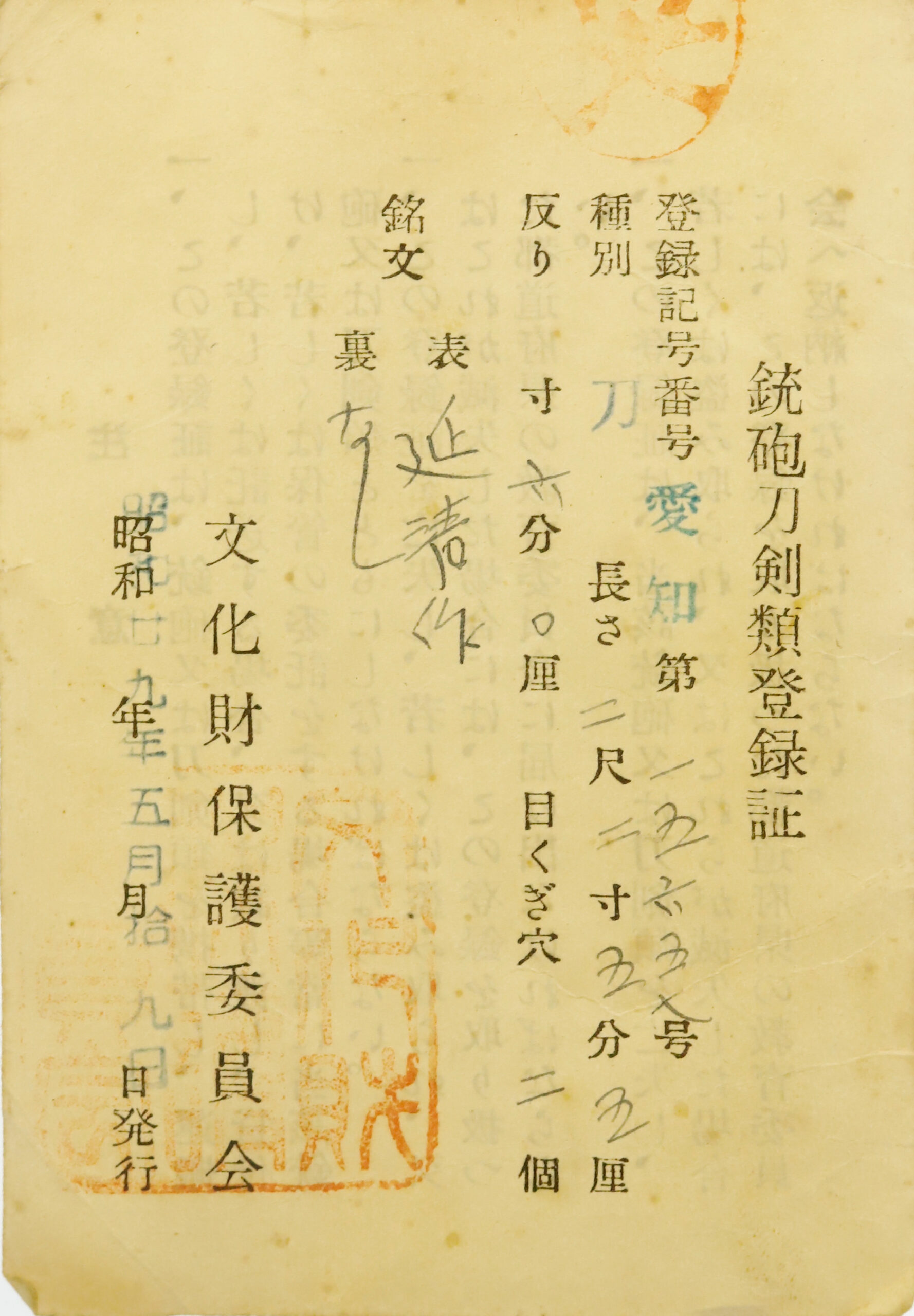

【About us】
Samurai Museum is located in Tokyo, Japan, exhibiting antique artifacts related to the Samurai history. Samurai Museum Shop is the place for those who are interested in Japanese culture and craftsmanship. We deal with antique Samurai swords/armor, traditional crafts made in Japan and so on.
【Review】
Here is one of the reviews we received from a customer who purchased an authentic Japanese sword from us. For more reviews, please click here.
“My experience overall with the whole process was wonderful. I had many questions about the history and process to purchase these treasures. All my questions were answered very timely and complete. The staff is very knowledgeable and very well versed if any questions do arise.”
【Japanese Sword& Export Process】
The Japanese swords we deal with are hand-forged edged swords made in Japan. It was made from the traditional carbon steel called TAMAHAGANE (玉鋼). Samurai Museum is familiar with the proper legal procedure for an antique/ authentic Japanese sword to be exported from Japan. We have sent more than 500 Japanese swords for the past three years (~2023) to amazing owners who appreciate its historical value.
Each Japanese sword is registered under the Agency for Cultural Affairs and the Board of Education in Japan. They issue a registration paper for each Japanese sword for its owner in Japan to legally possess it. The Japanese sword with its registration paper means it was traditionally hand-forged in Japan.
To legally export the sword from Japan to other countries, we will have to apply for its permit to the Agency for Cultural Affairs (Bunkacho) and return the original registration paper to the Board of Education. It normally takes around 2-4 weeks to receive this permit after submitting required documents. And we would like you to expect at least 1-1.5 months for your order to arrive at your given address after you ordered. For more detailed info, please click here.
It is allowed for residents in Japan to own authentic Japanese swords without a special license as long as they come with registration papers. Please feel free to contact us if you are a resident of Japan, whether temporarily or permanently. We will also assist you when you leave Japan and need to obtain the export permit.
【Payment Method】
We accept payment through Stripe (Credit card), PayPal, Apple Pay or ChromePay, all of which are secure payment methods. Also, you don’t need to make an account on Stripe for the checkout. If you prefer other payment method, please contact us. After confirming your payment, we will apply for an export permit. You may either pay in JPY, USD, AUD, CAD, EUR, CHF or GBP. The price is set in Japanese Yen. Prices in other currencies are automatically calculated based on the latest exchange rate.

*If the amount is above 1 million JPY, Stripe or wire transfer will be the only options for payment.
【Shipping】
We have shipped authentic Japanese swords to the USA, UK, Canada, Mexico, Germany, France, Hong Kong and Australia. If you don’t live in these countries and like to order, please contact us first before making a purchase. We offer Free International Shipping as long as we can send antique Japanese swords by EMS.
We normally ship by EMS (Express Mail Service) provided by Japan Post. We will send you a tracking number for your order as soon as we hand it to the post office. We will put 100 % insurance on the shipping document without any extra charge. Based on the total amount, there might be a duty tax or other fee for you to pay, depending on the countries. We use package cushioning to protect the item and put it in a PVC pipe, which is one of the most secure packages because of its durability.
It will normally take 5-14 days for the item to arrive at your given address after we dispatch it. Time of delivery is estimated as accurately as possible by the carrier but does not take into account any delays beyond our control such as by inclement weather, post office holiday seasons.
*If you live in Australia and like to purchase an authentic Japanese sword, please click here to know the detail.
*Please keep in mind that due to the spread of COVID-19, there might be delays in shipping. If you like to know the detail about shipping, please feel free to ask us.

【How to make sure the condition】
Please keep in mind that what you are going to purchase is an antique item. We uploaded high resolution photos for you to check its condition thoroughly. If you like to see more photos with different angles, please feel free to contact us. We will be happy to send them to you so that you can make informed decision. It is essential for us to know that you are happy with your choice of a sword. and we are prepared to use the best of our ability to serve you.
【How To Contact Us】
Please contact us through email, Facebook Messenger or Live Chat if you have any questions. You can find each icon on the right side of the website. Please click one of them to reach us. We will reply to you within 1-2 business days.
【The Art of Nihonto (Japanese Sword) 】
Samurai’s history is a profound, eloquent legacy of ancient Japanese warriors in which millions of people worldwide are being fascinated. If you like to find out the art of Nihonto, please click here.
【A Guide to Japanese Sword Maintenance】
After acquiring a genuine Japanese sword, it is also important to know how to take good care of it. Here is the special video for you. Mr. Paul Martin, Japanese sword expert, shows you how to give proper maintenance to your sword. By mastering how to clean the Japanese sword, its aesthetic beauty will last forever.
When you purchase a Japanese sword from us, you can get a Free Japanese sword maintenance kit. It comes with four tools (Choji Oil, Uchiko Whetstone Powder, Peg remover, Oil Applicator). By watching the video instruction above, you can enjoy learning how to maintain your Japanese sword while appreciating it. If you have any difficulty assembling the sword or cleaning the blade, you can feel free to contact us.


MORE ANTIQUE JAPANESE SWORD FOR SALE
SWORDS WITHOUT CERTIFICATES FOR SALE
LEARN JAPANESE SWORD TERMINOLOGY
Thank you for reading all the information on the page. If you have any difficulty choosing the right Japanese sword for you, we will be more than happy to help you find the one that speaks to you the most. Please feel free to contact us.
